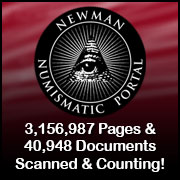
About UsThe Numismatic Bibliomania Society is a non-profit association devoted to the study and enjoyment of numismatic literature. For more information please see our web site at coinbooks.org SubscriptionsThose wishing to become new E-Sylum subscribers (or wishing to Unsubscribe) can go to the following web page link MembershipThere is a membership application available on the web site Membership Application To join, print the application and return it with your check to the address printed on the application. Print/Digital membership is $40 to addresses in the U.S., and $60 elsewhere. A digital-only membership is available for $25. For those without web access, write to: Charles Heck, Treasurer AsylumFor Asylum mailing address changes and other membership questions, contact Chuck at this email address: treasurer@coinbooks.org SubmissionsTo submit items for publication in The E-Sylum, write to the Editor at this address: whomren@gmail.com
BUY THE BOOK BEFORE THE COINSale Calendar
|
- WAYNE'S WORDS: THE E-SYLUM SEPTEMBER 27, 2020
- ASYLUM AUTUMN 2020 ISSUE PUBLISHED
- KÜNKER OFFERS POINSIGNON NUMISMATIC LIBRARY
- HAROLD DON ALLEN OCTOBER 2020 LIBRARY SALE
- NEW BOOK: CHARLETON CANADIAN COINS 74TH EDITION
- NEW BOOK: COIN YEARBOOK 2021
- NEW BOOK: CONNECTIONS, COMMUNITIES, AND COINAGE
- NEW BOOK: HELLAS BANKNOTES 1822-2020
- BOOK REVIEW: DISNEY NUMISMAGIC
- FIVE AND SIX POINT STARS ON BARBER COINAGE
- VIDEO: GREATER TULSA SHOW BRAVES CORONAVIRUS
- SUPPORT THE 2021 SILVER DOLLARS!
- NOTES FROM E-SYLUM READERS: SEPTEMBER 27, 2020
- MORE ON ENGRAVED CHARLES LINDBERG MEDALS
- 2021 NEW YORK INTERNATIONAL CANCELLED
- THE ART WORLD LURCHES TO THE FUTURE
- VOCABULARY TERM: MULTIPLE BLANKING
- HERBERT VON SEGGERN (1856-1957)
- HARVEY STACK'S NUMISMATIC FAMILY, PART 79
- JIM BISOGNANI REMEMBERS ED LEVENTHAL
- ARTICLE PROFILES GROVER CRISWELL
- PHILADELPHIA MINT WORKING OVERTIME
- ALFA NUMISMATICS AUCTION 1 CLOSES OCTOBER 4, 2020
- LARRY NESS INDIAN PEACE MEDAL COLLECTION
- ARCHIVES INTERNATIONAL AUCTION 61
- MARK T. RAY COLLECTION OF ENGLISH BANKNOTES
- H. DON ALLEN EPHEMERA COLLECTION SELECTIONS
- NUMISMATIC NUGGETS: SEPTEMBER 27, 2020
- MONEY PEOPLE HATED: DAMNATIO MEMORIAE
- COIN REPRESENTED THE FIVE WOUNDS OF CHRIST
- THE SINAW HOARD FOUND IN OMAN
- RENAISSANCE PLAQUETTE ATTIBUTED TO LOMBARDO
- THE 1864 ATLANTIC INTERNATIONAL CLUB MEDAL
- DICKIN MEDAL FOR CAMBODIAN LANDMINE RAT
- LOOSE CHANGE: SEPTEMBER 27, 2020
- FEATURED WEB SITE: ENGLISH HAMMERED COINS
Click here to access the complete archive
Click here to unsubscribe (scroll down)
To comment or submit articles, reply to whomren@gmail.com
Content presented in The E-Sylum is not necessarily researched or independently fact-checked, and views expressed do not necessarily represent those of the Numismatic Bibliomania Society.
WAYNE'S WORDS: THE E-SYLUM SEPTEMBER 27, 2020
 New subscribers this week include:
Tracy Ibberson, courtesy Bill Myers;
Mike Coltrane, courtesy of Maureen Levine;
Jay Kimmel, and
Elaine Wooton.
Welcome aboard! We now have 6,563 subscribers.
New subscribers this week include:
Tracy Ibberson, courtesy Bill Myers;
Mike Coltrane, courtesy of Maureen Levine;
Jay Kimmel, and
Elaine Wooton.
Welcome aboard! We now have 6,563 subscribers.
Thank you for reading The E-Sylum. If you enjoy it, please send me the email addresses of friends you think may enjoy it as well and I'll send them a subscription. Contact me at whomren@gmail.com anytime regarding your subscription, or questions, comments or suggestions about our content.
This week we open with a new issue of The Asylum, two numismatic library offerings, four new books, one review, and updates from the Newman Numismatic Portal.
Other topics this week include Canadian coins, Greek banknotes, Disney Dollars, the proposed 2021 silver dollars, Lindberg medals, show cancellations, dealers Herbert von Seggern, Ed Leventhal and Grover Criswell, multiple auction previews, damnatio memoriae, and a Dickin medal for a Cambodian rat.
To learn more about Revue Numismatique, the Catalogue of Catalogues, family medals, multiple blanking, collector Martin F. Kortjohn, overtime at the Philadelphia Mint, Indian Peace medals, Guernsey overprints, reversible money, and squatting Numismatica, read on. Have a great week, everyone!
Wayne Homren
Editor, The E-Sylum
ASYLUM AUTUMN 2020 ISSUE PUBLISHED
Maria Fanning edits our print journal The Asylum, and she submitted this report on the latest issue. Thanks. I'm looking forward to it! -Editor
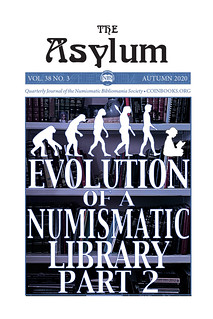 The Asylum, Autumn 2020
The Asylum, Autumn 2020
"Evolution of a Numismatic Library, Part 2"
The Asylum's Autumn 2020 edition Special Issue, "Evolution of a Numismatic Library, Part 2" will be in NBS members' mailboxes soon. Thanks again to all members who shared stories and photos of your wonderful numismatic libraries.
Congratulations to all of the members who helped The Asylum win First Place in the American Numismatic Association's Outstanding Specialty Numismatic Publication award! It is your contributions that keep this journal so vibrant.
I hope you all had an opportunity to attend the NBS 41st Annual General Meeting during the Newman Numismatic Portal Symposium and to watch the many great presentations included that weekend. Included in this issue, we have reports from the meeting, The Asylum awards and the results of our Benefit Auction.
The deadline for our next issue will be November 1, 2020. Keep those stories coming!
Remember, while The E-Sylum is free to all, only paid members of NBS receive our great print journal The Asylum. -Editor
To join NBS or renew your membership, see:
https://www.coinbooks.org/about/membership.html
THE BOOK BAZARRE
KÜNKER OFFERS POINSIGNON NUMISMATIC LIBRARY
The numismatic library of French coin dealer Alain Poinsignon will be sold in Künker's auction 342 in November. Here's the press release. -Editor
Rare as Well as Useful – Alain Poinsignon's Numismatic Library
Künker's auction 342 on 2 and 3 November 2020 will be a literature-only auction. The research library of French coin dealer Alain Poinsignon will be on offer. It contains important numismatic reference works that were published between the 19th and 21st centuries and cover a broad spectrum of subjects from antiquity to present times.
Alain Poinsignon, founder of Poinsignon Numismatique in Strasbourg, is one of the most important coin dealers of the country. At the IAPN, he was head of the IBSCC, the International Bureau for the Suppression of Counterfeit Coins. Moreover, he was a permanent member of the board of the French professional association SNENNP.
Now, Alain Poinsignon is enjoying his well-earned retirement, his son Régis Poinsignon took over the store, and his extremely well-stocked library will be auctioned off at Künker over the course of three auction sales. The first one is auction 342 taking place on 2 and 3 November. The sale will be held as a traditional room auction in the premises of the Künker auction house. All those who cannot be there in person will have the option of live bidding via Auex and the usual possibilities of bidding via e-mail or phone. In a subsequent eLive Premium Auction on 4 and 5 November, the second part of the library, which also features a broad selection of items, will be on sale. The third part mainly contains older auction catalogues that are valuable sources for identifying provenances. This part will be on sale in another eLive Premium Auction following the 2021 Spring Auction Sales.
The library, which was built up over more than 40 years, comprises about 11,000 items, a lavish spectrum of monographs, anthologies, catalogues, special editions and journal volumes of a broad range of topics, an impressive amount of numismatic information, which has been bundled into approx. 4,500 lots for these auction sales. Thus, coin enthusiasts of all kinds have the chance to acquire numerous rarities, magnificent volumes and useful standard works that can only be found on the market on rare occasions. Among the 1,000 lots of auction 342 are many items with unusually low starting prices. Moreover, book lovers will encounter many beautiful bookplates. Seize this opportunity to enrich your own library!
Antiquity
The auction starts with several lots on general numismatics, followed by a large section on
ancient coinage. In this part, you will find numerous lots on Greece, including the complete
series of the British Museum's Catalogue of Greek Coins published between 1873 and 1927.
The abundant offer in the field of Celtic numismatics is also worth mentioning. One of the
highlights from the section of works on Roman coinage is Ernst Justus Haeberlin's work Aes
grave. Das Schwergeld Roms und Mittelitaliens, which comprises two volumes.
Middle Ages and Modern Times
Following works on the Migration Period and Byzantium, we find the section
Middle Ages and modern times.
The main focus is on a large selection of works on German and French
numismatics. However: the well-equipped library also contains literature on the coinage of
most countries and has something to offer for almost every special collector. Moreover, the
Poinsignon Collection includes many works on medals, plaquettes and jetons. At this point,
we would like to mention Habich's standard work Die deutschen Schaumu¨nzen des XVI.
Jahrhunderts.
Journals and Series
The sale is rounded off by about 50 lots made of journals and series. This is a rare opportunity
to purchase complete or almost complete series. Among them is the complete set of Blätter
für Münzfreunde published between 1865 and 1963 as well as the almost complete collection
of the issues of the important traditional magazine Revue Numismatique published between
1836 and 2017.
The catalogue can be ordered at Künker, Nobbenburger Straße 4a, 49076 Osnabrück; phone: +49 541 962020, fax: +49 541 9620222; or via e-mail: service@kuenker.de. You can access the auction catalogues online at www.kuenker.de. If you want to use live bidding, please remember to register for this service in good time. You will be informed about any changes, e.g. regarding the schedule or the location of the auction sale, in the Künker newsletter and at www.kuenker.de.
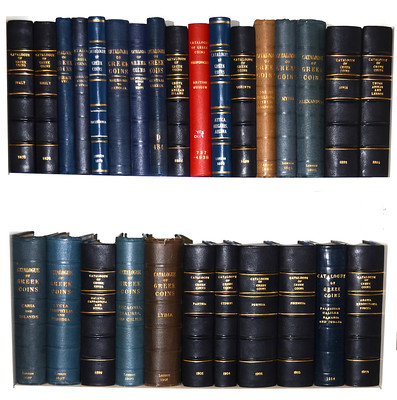
Lot 41
No. 41: BRITISH MUSEUM. Catalogue of Greek Coins. 29 volumes, entire series of the 1873-1927 London original edition in various individual volumes: original full cloth binding (12), older full cloth library binding (1), younger full cloth binding in the style of the original edition's binding (1), younger full leather binding (2), older half Moroccan leather binding (1), Poinsignon half leather binding (12). (29) Estimate: 2,500 euros
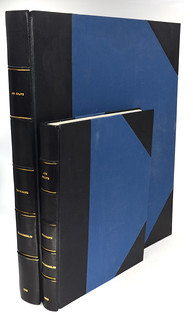 No. 214: HAEBERLIN, E.J. Aes grave. Das Schwergeld Roms und Mittelitaliens
einschließlich der ihm vorausgehenden Rohbronzewährung. 2 volumes, Frankfurt (Main)
1910. XXVIII, 280 p., 1 plate.; 103 plates. Quarto (text volume) and atlas folio (plate
volume). The text volume's original front and back paperback covers are bound in.
Poinsignon half leather binding. (2) Estimate: 1,500 euros
Copy from Bibliothek Münzen und Medaillen AG, Fritz Rudolf Künker Auction 102,
Osnabrück 2005, No. 3772 (there still in half leather and half cloth bound folder).
On the pre-title there is the handwritten indication of ownership by coin dealer Lucien Naville
and the erased stamp of German-Swiss art and coin dealer Dr. Jacob Hirsch (*1874, +1955),
Munich.
No. 214: HAEBERLIN, E.J. Aes grave. Das Schwergeld Roms und Mittelitaliens
einschließlich der ihm vorausgehenden Rohbronzewährung. 2 volumes, Frankfurt (Main)
1910. XXVIII, 280 p., 1 plate.; 103 plates. Quarto (text volume) and atlas folio (plate
volume). The text volume's original front and back paperback covers are bound in.
Poinsignon half leather binding. (2) Estimate: 1,500 euros
Copy from Bibliothek Münzen und Medaillen AG, Fritz Rudolf Künker Auction 102,
Osnabrück 2005, No. 3772 (there still in half leather and half cloth bound folder).
On the pre-title there is the handwritten indication of ownership by coin dealer Lucien Naville
and the erased stamp of German-Swiss art and coin dealer Dr. Jacob Hirsch (*1874, +1955),
Munich.
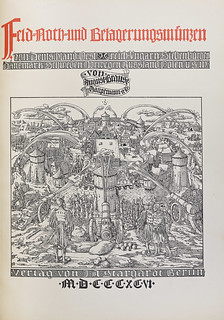
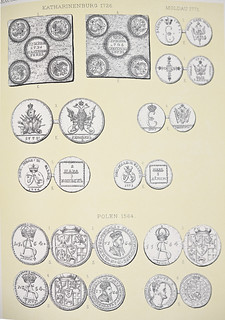
Lot 309
No. 309: BRAUSE-MANSFELD, A. Feld-, Noth- und Belagerungsmünzen. Complete set comprising 2 volumes, bound in one volume: Berlin 1897 and 1903; XI 118 p., 55 plates; VIII, 80 p., 38 plates. Frontispiece. Folio. Poinsignon half leather binding. Estimate: 1,000 euros Copy from Fritz Rudolf Künker Auction 169, Osnabrück 2010, No. 663 (there still in full cloth binding).
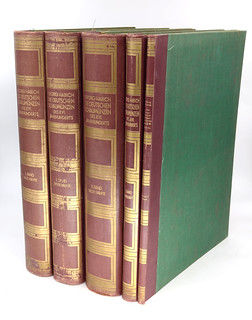
![AdobeStock_108478862 [Konvertiert]](https://c1.staticflickr.com/1/768/50367779736_596d781fe5_n.jpg)
Lots 860 and 994
No. 860: HABICH, GEORG. Die deutschen Schaumünzen des XVI. Jahrhunderts. 2 volumes and index volume in 5 volumes. Munich 1929-1934. CXXXII, 557 p. with numerous images, 334 plates; 48 p. Folio. Original half cloth binding. (5) Estimate: 2,500 euros
No. 994: REVUE NUMISMATIQUE. Founded as REVUE DE LA NUMISMATIQUE FRANÇOISE by E. CARTIER/L. DE LA SAUSSAYE. 1st series (1836-1855), 2nd series (1856-1870, 1874-1877), 3rd series (1883-1896), 4th series (1897-1936), 5th series (1937- 2003), 6th series (2004-2017). Almost complete set of this important journal, which is still published today. Only 4 issues from recent times (2002, 2007, 2008 and 2010) are missing. Estimate: 10,000 euros

HAROLD DON ALLEN OCTOBER 2020 LIBRARY SALE
Laura Ashton writes:
"Thanks again for your kind words following the passing of our father, H. Don Allen.
"Many people have asked about next steps for his large collection and library. I am pleased to share that hundreds of items are included in the Toronto Coin Show virtual auction scheduled to take place October 1 and 2, 2020.
"A video highlighting the H. Don Allen collection is featured in this video, just released this week: https://youtu.be/IhwsMrfi9Hk
"The lots are all detailed on the auction site. In the search bar on the right, type in "Allen" to filter just his collection.
http://auctions.gbellauctions.com/Toronto-Coin-Expo-Fall-Sale-2020_a41320?m=all
The inventory is substantial and includes books (many of them signed), world paper money, promissory notes, "school currency", cheques, coins, tokens, vecturist items, medals, ration exchange, gaming chips, Cinderella/ephemera, and much more. "
Here's an excerpt from the Geoffrey Bell announcement. -Editor
Noted Canadian numismatist Harold Don Allen passed away in July, shortly after his 89th birthday. Dr. Allen began collecting at least seventy years ago, if not longer. His interests were unusually wide ranging, and he was never content with merely accumulating money and its substitutes. He investigated the stories that his collectibles told, from many different angles, and was a prolific numismatic writer, speaker, and dedicated hobby booster. His early publication, Canadian Numismatic Digest, was published sixty years ago.
In it he typically covered an exceedingly wide waterfront, and the book still makes excellent and instructive reading today. Geoffrey Bell Auctions is honoured to present Dr. Allen's ephemeral material, which includes ersatz money of many kinds, and by no means restricted to items of Canadian origin. Each lot will include one of Don's personal tokens.
I've included some literature lots here. See another article elsewhere in this issue with additional non-book selections. -Editor
Lot 808: Paper Money Catalogue Lot
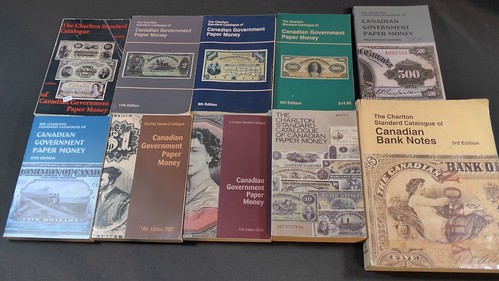
An assortment of 10 bank note catalogues spanning the early years of the book's publication. A great reference for the collector. Lot includes the coveted 1st editions of "The Charlton Standard Catalogue of Canadian Government Paper Money" and "The Charlton Standard Catalogue of Canadian Paper Money" highlighting the chartered banks of Canada. Some of the catalogues have annotations by Don Allen.
These group lots are good opportunities to fill in holes or upgrade. -Editor
To read the complete lot description, see:
H. Don Allen Collection - Charlton Bank Notes / Paper Money Catalogue Lot
(http://auctions.gbellauctions.com/H-Don-Allen-Collection-Charlton-Bank-Notes-Paper-Money-Catalogue-Lot_i38481505)
Lot 809: Bank Notes and Currency, Part 1
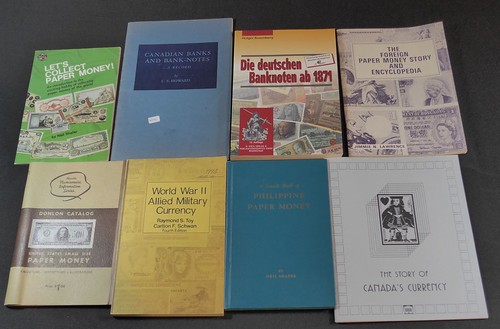
A nice diverse lot. Highlights include "The Story of the American Bank Note Company", "Gunnar Andersen Banknotes", "Collecting Paper Money and Bonds", and "Catalog of Paper Money Around The World" signed by author. Some books include annotations and news stories added by Don Allen.
To read the complete lot description, see:
H. Don Allen Collection - Large Lot of Books and Catalogues - Bank Notes and Currency, Part 1
(http://auctions.gbellauctions.com/H-Don-Allen-Collection-Large-Lot-of-Books-and-Catalogues-Bank-Notes-and-Currency-Part-1_i38481506)
Lot 810: Bank Notes and Currency, Part 2
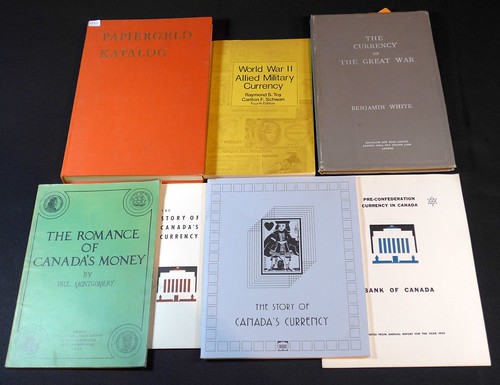
A nice diverse lot. Highlights include "Ten Decades Ago, 1840-1850: A Study of the Work of Rawdon, Wright, Hatch and Edson of New York City", "The Currency of The Great War" and "Australian Superscribed Banknotes". Some books include annotations and inserted news stories.
To read the complete lot description, see:
H. Don Allen Collection - Large Lot of Books and Catalogues - Bank Notes and Currency, Part 2
(http://auctions.gbellauctions.com/H-Don-Allen-Collection-Large-Lot-of-Books-and-Catalogues-Bank-Notes-and-Currency-Part-2_i38481507)
Lot 812: Numismatic and Banking Literature
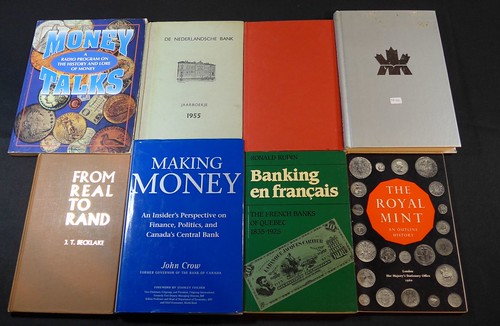
An exciting lot of numismatic literature spanning the spectrum of history in collecting. Highlights include the "Striking Impressions" book signed by James Haxby and "The Royal Canadian Mint Selection Committee for the 1986 Commemorative Coinage". A must for your library. Some books include personal annotations and news stories added by Don Allen.
There are additional photos online. The Haxby book is signed by nine members of the Royal Canadian Mint Selection Committee for the 1986 commemorative coinage. -Editor
To read the complete lot description, see:
H. Don Allen Collection - Collection of Numismatic and Banking Literature
(http://auctions.gbellauctions.com/H-Don-Allen-Collection-Collection-of-Numismatic-and-Banking-Literature_i38481509)
Lot 821: International Bank Note Society Journals
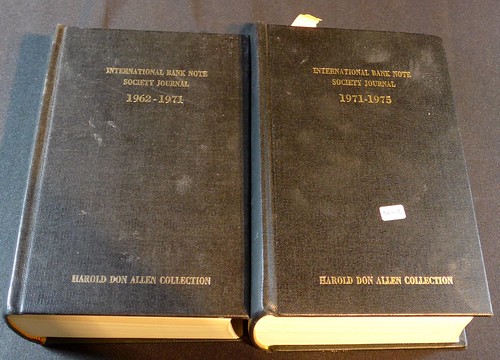
Expertly bound in two volumes, International Bank Note Society Journals, 1962-1971 and 1971-1975 with notation on the cover "Harold Don Allen Collection".
Great journal in a nice binding. -Editor
To read the complete lot description, see:
H. Don Allen Collection - International Bank Note Society Journals, 1962-1975
http://auctions.gbellauctions.com/H-Don-Allen-Collection-International-Bank-Note-Society-Journals-1962-1975_i38481518
To see the complete consignment listing:
H, Don Allen Collection
(http://auctions.gbellauctions.com/Toronto-Coin-Expo-Fall-Sale-2020_a41320?m=all&p=1&ps=50&so=1&q=allen&hi=0&vm=1)
To read the earlier E-Sylum article, see:
DR. H. DON ALLEN (1931-2020)
(https://www.coinbooks.org/v23/esylum_v23n29a07.html)
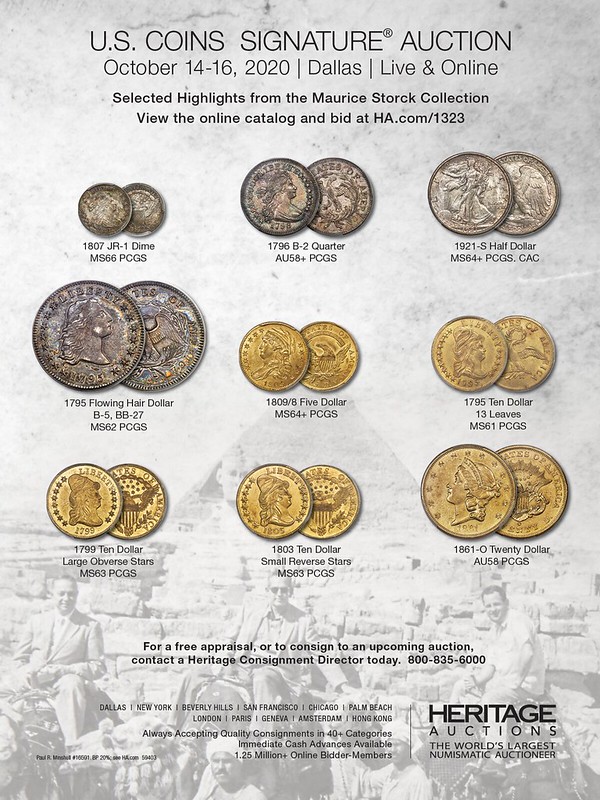
NEW BOOK: CHARLETON CANADIAN COINS 74TH EDITION
The Trajan Media Coin and Stamp Supplies site now lists for preorder the new 2021 Charleton Canadian Coins book, available in both English and French versions. -Editor
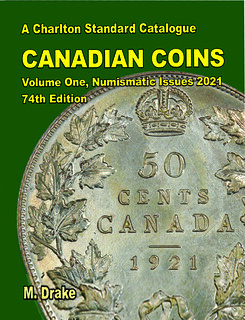
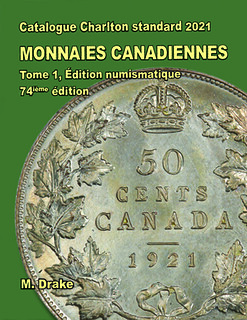
2021 CHARLTON CANADIAN COINS VOLUME 1: NUMISMATIC ISSUES – 74TH EDITION
$29.95
First published in 1952 the Charlton Standard Catalogue of Canadian Coins has reported on all aspects of the Canadian numismatic scene, from the coinage of the French Regime to the business strikes of today. For more than 65 years Charlton has been the bible for collectors.
With this new edition, prices have been updated to reflect current selling prices in the marketplace; several new varieties have been added and include many more images for the collector; the modern proof issues for each denomination have been reworked into a more suitable framework for viewing purposes. The Major Obverse Varieties have been renamed to better reflect the current attitudes in the marketplace. Gold & silver prices have been steadily climbing this past year, so trend prices have been modified to factor in this commodity price change in the marketplace. 336 pages.
For more information, or to order, see:
2021 CHARLTON CANADIAN COINS VOLUME 1: NUMISMATIC ISSUES – 74TH EDITION
(https://coinstampsupplies.com/product/2021-charlton-canadian-coins-volume-1-numismatic-issues-74th-edition/)
NEW BOOK: COIN YEARBOOK 2021
Token Publishing (publisher of Coin News and Medal News) is releasing a new edition of their Coin Yearbook. Here's the information from their web site. -Editor
Coin Yearbook 2021
£9.95
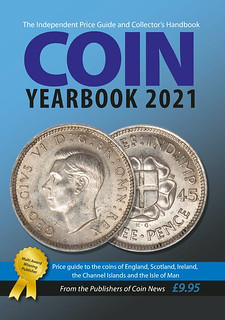 LAUNCHED SEPTEMBER 28! The COIN YEARBOOK is now firmly established as the book used by both collectors and coin dealers alike and is the independent price guide and collector's handbook for the coin collecting hobby. Fully revised and updated, the COIN YEARBOOK 2021 will once again feature accurate up to date prices for English, Scottish, Irish and Island coins (the IOM fully updated for 2021) with the coins illustrated in full colour.
LAUNCHED SEPTEMBER 28! The COIN YEARBOOK is now firmly established as the book used by both collectors and coin dealers alike and is the independent price guide and collector's handbook for the coin collecting hobby. Fully revised and updated, the COIN YEARBOOK 2021 will once again feature accurate up to date prices for English, Scottish, Irish and Island coins (the IOM fully updated for 2021) with the coins illustrated in full colour.
The easy to use price guide covers: Ancient coins used in Britain (Celtic and Roman – ideal for metal detectorists) Hammered coinage 959-1663, Milled coinage and Modern decimal coinage. AND THIS YEAR THERE'S A BRAND NEW SECTION ON BRITANNIAS TOO! ...and all for just £9.95 that's the SAME PRICE as last year! (p+p free if ordered before September 11, overseas delivery charges will apply, discount equivalent to UK postage)
For more information, or to order, see:
Coin Yearbook 2021
(https://www.tokenpublishing.com/shop/product/8050)
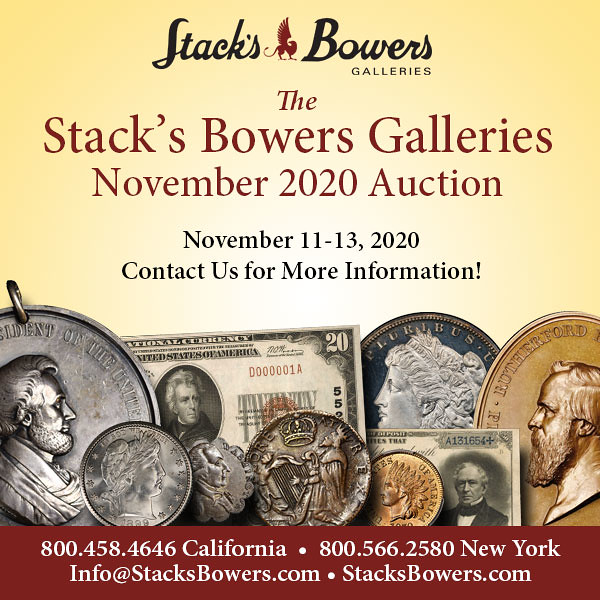
NEW BOOK: CONNECTIONS, COMMUNITIES, AND COINAGE
The American Numismatic Society has published a new book on coin production in Southern Asia Minor. -Editor
Connections, Communities, and Coinage: The System of Coin Production in Southern Asia Minor, AD 218–276
(Numismatic Studies 39)
By George Watson
$100
?member price: $70
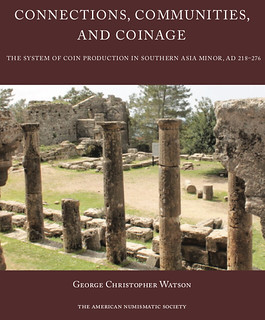 The chief aim of the book is to address the system of coin production in the regions of Pamphylia, Pisidia and Cilicia during the third century AD. As in much of the Roman East, cities in these regions produced their own bronze coinage, but that this was in some respects collaboratively achieved is shown by the use of the same obverse dies by two or more cities, as well as the appearance of the same engraving style in multiple cities. The most comprehensive study of these phenomena to date is the work of Konrad Kraft, Das System der kaiserzeitlichen Münzprägung in Kleinasien, which was published posthumously in 1972. The book not only examines these questions in an area which was not explored in detail by Kraft, but also radically reappraises his conclusions and opens up new avenues of investigation.
The chief aim of the book is to address the system of coin production in the regions of Pamphylia, Pisidia and Cilicia during the third century AD. As in much of the Roman East, cities in these regions produced their own bronze coinage, but that this was in some respects collaboratively achieved is shown by the use of the same obverse dies by two or more cities, as well as the appearance of the same engraving style in multiple cities. The most comprehensive study of these phenomena to date is the work of Konrad Kraft, Das System der kaiserzeitlichen Münzprägung in Kleinasien, which was published posthumously in 1972. The book not only examines these questions in an area which was not explored in detail by Kraft, but also radically reappraises his conclusions and opens up new avenues of investigation.
For more information, or to order, see:
US:
Connections, Communities, and Coinage: The System of Coin Production in So
(https://www.oxbowbooks.com/dbbc/connections-communities-and-coinage.html)
Rest of World:
Connections, Communities, and Coinage: The System of Coin Production in Southern Asia Minor, AD 218–276 [Hardback]
(https://www.oxbowbooks.com/oxbow/connections-communities-and-coinage-64652.html)
NEW BOOK: HELLAS BANKNOTES 1822-2020
A three-volume work on Greek banknotes has been published. Found via News & Notes from the Society of Paper Money Collectors (Volume VI, Number 13, September 15, 2020). -Editor
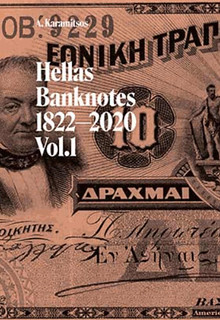
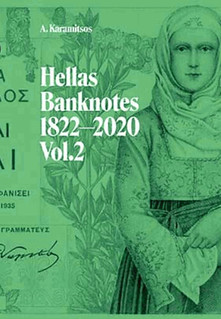
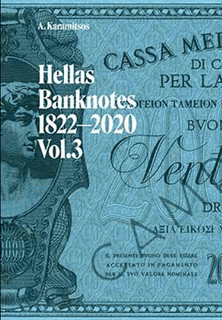
Hellas Banknotes 2020 (In Three Volumes)
by A.Karamitsos
Hellas Banknotes 2020 (Publication July 2020 - In Three Volumes) Three bilingual (Greek & English), full colour volumes (over 800 pages in total)
Volume I: It consists of the issues of the Provisional Administration of Greece during the Greek revolution, the Greek state's bonds and the issue of the Phoenix, the 87 years operation of the National Bank of Greece and all its issues, as well as the Phalanx credit notes that existed at the same period. Furthermore, in the first volume there are, the Ionian Bank, the privileged Bank of Epirothessaly and the Bank of Crete issues.
Volume II: It contains the issues of the Bank of Greece till the introduction of Euro, European Union's currency.
Volume III: The third volume includes notes that were issued, locally or nationally by domestic issuing authorities or foreign forces on behalf of Greece.
The "Hellas Banknotes" catalogue describes the history of the Hellenic banknotes from the establishment of the Provisional Administration during the Greek Revolution till the nowadays European Union's common currency unit, Euro. As Greece is a country with a turbulent modern history, which for 150 years was under constant civil or external wars, a very interesting (world widely) economic environment was created, banknotes using the currency unit of foreign countries, fractional currency, bisected and cut banknotes, internal loans' bonds, values higher than the denomination (NN Issue) and much more that we will analyse through the catalogue. After a lot of research we gathered as much information as possible and we tried to write them down in few lines in every chapter.
PRICE €45
For more information, or to order, see:
Hellas Banknotes 2020 (In Three Volumes)
(https://www.karamitsos.com/item.php?type=book&id=fJbcbMKdGzi0jXN8KuJ8VrJTXbulQXl6)
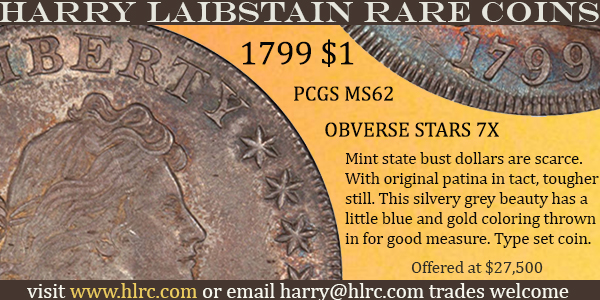
BOOK REVIEW: DISNEY NUMISMAGIC
John and Nancy Wilson submitted this review of Disney NumisMagic, the new book on Disney Dollars. Thanks! -Editor
Author not named and Published by: CVM Enterprises
Reviewed by John and Nancy Wilson, NLG
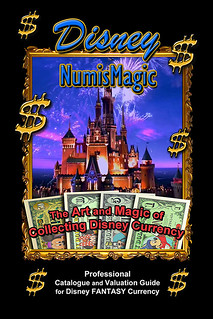 Disney NumisMagic – The Art and Magic of Collecting Disney Currency – Catalogue and Valuation Guide for Disney FANTASY Currency is a 252-page hard bound reference with color illustrations, an up-to-date price guide, and Disney information.
Disney NumisMagic – The Art and Magic of Collecting Disney Currency – Catalogue and Valuation Guide for Disney FANTASY Currency is a 252-page hard bound reference with color illustrations, an up-to-date price guide, and Disney information.
Teddy Ryan III wrote that he has been compiling data for over 30 years, and it has taken him longer than he thought to get it finally published. We can understand the 30 plus years he took to compile this information on the Disney Currency that is contained within the pages of this reference. It contains Disney history along with all notes and other numismatic related information. Starting in 1987, the notes have an engraved border designed by the American Bank Note Company (ABNCo). Several other Bank Note Companies were involved in the early issues, but the ABNCo won the contract.
Printed in the USA, the book isn't endorsed by the Walt Disney Company, and according to the reference is, "unofficial and unauthorized". With several other references on Disney Dollars in print, the author did not use other references or price guides.
The price guide shows the fair market value at retail for collectors at the time of publication. The release of the Disney dollars in 1987, at least for us, was a dream come true.
It starts with collecting bank notes and currency which leads into the Fantasy Currency in this reference which are forms of money and coupons which are assigned with make-believe subjects and fictitious topics. It discusses the amusement parks and their growth along with different types of memorabilia, and other items used in the parks including the novelty currency. It is interesting to note that he mentions how many U.S. currency notes are issued on a daily basis, and the very insignificant amounts of fantasy currency (actually mimic U. S. Currency) which was issued. The author uses the International Bank Note Society (IBNS) grading standards. It is a rarity to see a circulated note because when they were used as cash at a Disney park they were destroyed. The author discusses the natural and unnatural defects which can happen when they are circulated.
Chapter one covers the Walt Disney history and timeline. The timeline starts in 1923 and goes up to 2021 Walt Disney World's 50th Anniversary. In 1923 Walt and Roy signed a contract with M. J. Winkler to produce a series of "Alice Comedies." The Mickey Mouse biography follows with his screen debut was Steamboat Willie, in November, 1928. They next discuss everything about Mickey Mouse. The Artwork of Disney Fantasy Currency explains the totally invented or concocted design of the fascinating currency including Mickey, Goofy, Minnie, Donald, Tinkerbell, along with other scenes that are within the parks.
Chapter Two contains Disney fantasy currency particulares. We collect these dollars, and this is the first time we have heard them called particulares. They are also described as private currency notes or paper money issued by merchants which are printed by anyone other than a legally authorized government agency. The next chapter discusses the story of Disney fantasy currency tracing its history to the original Disney studios in the 1930's. Walt Disney then first licensed the use of Mickey Mouse Money and was distributed during the Mickey Mouse Club meetings. The scarce two types of Mickey Mouse coupons, one, five and ten, are discussed later. They are priced in several different grades with about uncirculated (AU) being the highest. Many of the ‘Cone Dollars' were also placed as free coupons in the Mickey Mouse Magazine.
The price for these 1930's magazines runs from $15 in Fine to $500 to $1500 in AU. WW ll Disney War bond certificates and Magic Kingdom Club OPERATION M.O.U.S.E money which cover numerous issues follow. With the exception of the war bonds the rest are very rare. Nancy Opitz Wilson has one issued to her in the 1940's, and we still have it. With all the Disney characters in the borders it will be passed down to our heirs. A few Magic Kingdom membership cards can also be found. The chapter closes out with Disneyland Dollars (early issues), Happy Dollars, Recreation Coupons, Vacation Club Sand Dollar, a Promotional Dollar and El Capitan Theatre Dollars. All these issues are well illustrated, described and priced though the El Capitan prices for Gem and AU-Unc are in the wrong column.
Chapter Three, The Official Disney Dollars – 1st Generation (Traditional) starts with a fact card containing a Mickey dollar which explains it, followed by a Disney Press Release dated in 1987 explaining their release at the theme park in Anaheim. A June 4, 1987 Cast Member Publication article which featured "Getting Our Money into Circulation," shows a photo of Creative Services Illustrator, Matt Mew, signing a sheet of notes (probably a Proof Sheet depicting Mickey – 1987 Series of the new Disney Dollars. We have an 18-subject sheet of the series 1987, depicting Mickey number 56 / 750 and signed by Mr. Mew. The Inaugural Issues of the 1987 follow in denominations of one and five. The backs have different backs which determines what series they are. Well-illustrated photos and prices follow to the Series of 1999 ($1, $5 and $10). The chapter ends with Little Known Disney Dollar chronicles.
We have the Official Disney Dollars "2nd generation" (themed). The dollars are covered from 2000 through the 2014 issues. The Disney company decided to have more frequent changes in the designs on their currency. They also began to discover more unique ways to market these same items. Every Disney character was used in these 2nd generation issues. There are three pages of information on the Pirates of the Caribbean attraction and Disney Dollar issues. The end of Disney Dollars came when the Disney Company wanted patrons to use gift cards and other forms of electronic transactions or digital currency. Though not issued any more, you can still use your Disney Dollars at any of their parks as actual cash.
Many of the Disney Dollars which were issued from 1987 to 2014 probably have some specimens and proofs (Intaglio or Lithographic), and or test notes. Proof and Specimen are not only well illustrated, but also explained. All notes have serial numbers which are zeros. Many proprietary proofs were created for sale to the general public and collectors." Some were cut up and sold individually. No prices on these notes are shown, and we can assume that most are very scarce.
Disney Dollars errors – FREAKS and ODDITIES (EFOs). EFOs are hardly ever encountered, even though a note that had flaws was still released for circulation. Many of the EFOs are illustrated. The production of Disney Dollars had the back printed first followed by the face printing and then the overprinting which was probably the most difficult. Error notes consist of multiple errors, incomplete printing (unprinted) and (insufficient ink), ink stain or smear, out of register printing, serial numbers, incorrect printing (design error), and misspelled words. Freaks consist of missing color and overprint, omission error, paper error and value error. Freaks are rarely found. Oddities consist of inverted or incorrect printing (location error) and print location (wrong end). Fancies would consist of radars, repeaters, ladder, solid, binary and dates. It is possible to have two or more of these fancies and or EFOs on one Disney Dollar. No prices are listed. Errors shouldn't be possible with the Disney Dollars (except minor flaws), but unscrupulous employees who are printing them remove them illegally from the building and sell them to friends or associates.
Limited Editions and Framed Sets. Many of these were sold through Disney Merchandise locations worldwide. We purchased our framed 1987 $1 Disney Sheet at the Orlando park and enjoy looking at it and showing friends. Early in their release it was very easy to obtain $1 and $5 (1987) sets with matching serial numbers as well as Proof Sheets. Our 18 subject 1987 $1 sheet cost $295 framed at the park, with one selling in 2013 for $745. All the other framed sets consisting of two and more up to 18 subject sheets. Some collectors cut up sheets to obtain a special note. Mr. Disney is well known for his famous quotes and quips such as, "That's the real trouble with the world, too many people grow up."
A Notaphilist is defined as an individual who studies banknotes, paper money or currency. The Valuation Guide covers every issue along with many other memorabilia in this reference. The author has over 30 years of research in auctions, Worthpoint, International Bank Note Society, Professional Currency Dealer Association, dealers and other sources. He says that the prices listed should only be used as a "guide for the purpose of a reference". On the last two pages you will find a petition with the Disney Company address and a place for your signature for you to send to Disney and request for consideration, "To please bring back Disney Dollars," which were discontinued on May 14, 2016. The author and publisher have no problem with anyone either cutting this petition out of the book or making copies of them to either sign themselves or have friends sign them.
This book is an outstanding resource of well researched information on Disney Dollars, and other related items. We all love Mickey, Donald, Goofy and other Disney characters. Although the Disney Co. retired and removed its Fantasy Dollars from circulation in 2016, The Disney Dollars Currency is still going strong in the hearts of collectors.
To obtain a copy of this reference contact CVM Enterprises who released the book: Disney Numismagic – The Art and Magic of Collecting Disney Currency (ISBN: 978-0-9890441-7-2) at a Retail Price of ONLY $34.95 – Printed POD by (Ingram Books / Ingram Spark) and available direct from the publisher CVM Enterprises cvm.enterprises@gmail.com . Or to purchase the book go to this web page: www.Disney-NumisMagic.com . The author gave us his eBay site which gives you 20% off if you purchase more than one with free shipping: https://www.ebay.com/itm/978-0-9890441-7-2/143740618630?hash=item21779bc786:g:MMAAAOSwxklfYkyv. We went to www.amazon.com and found it there for $34.95 and if you have Prime it ships free. Finally, the author told us it is, wholesale (20% off) direct from 'Ingram Books' or Ingram Spark-Lightning Source (which are Ingram's POD divisions).
To read the earlier E-Sylum article, see:
NEW BOOK: DISNEY NUMISMAGIC
(https://www.coinbooks.org/v23/esylum_v23n36a06.html)

FIVE AND SIX POINT STARS ON BARBER COINAGE
Newman Numismatic Portal Project Coordinator Len Augsburger provided the following report on U.S. Mint correspondence concerning the number of points on stars on the Barber silver coinage. Thanks. -Editor
A Debate Over Star Points
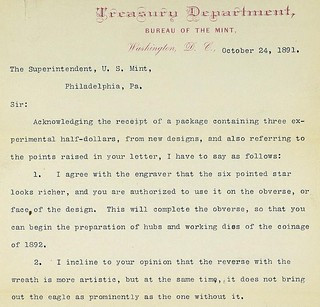 Barber silver coins (1892-1916) have six-pointed stars on the obverse, and five-pointed stars on the reverse. Why? Five-pointed stars grace the U.S. flag, and the Great Seal of the United States follows suit. A recent bit of U.S. Mint correspondence, scanned and transcribed by Newman Portal, sheds light on the situation in 1892, with the advent of Barber coinage.
Barber silver coins (1892-1916) have six-pointed stars on the obverse, and five-pointed stars on the reverse. Why? Five-pointed stars grace the U.S. flag, and the Great Seal of the United States follows suit. A recent bit of U.S. Mint correspondence, scanned and transcribed by Newman Portal, sheds light on the situation in 1892, with the advent of Barber coinage.
Heretofore, the six-pointed star was featured on the obverse of the Liberty Seated coinage since 1838 (the 1837 Liberty Seated dime was the no stars variety), while Draped Bust coinage featured six-pointed stars on both obverse and reverse.
Mint Director Leech wrote to Philadelphia Mint Superintendent in October 1891 "I agree with the engraver that the six pointed star looks richer, and you are authorized to use it on the obverse" while "the five pointed stars will be used on the reverse," with no additional explanation. All the known pattern pieces exhibit this scheme. So, the obverse use of six-pointed stars seems to have been simply the preference of the engraver, which withstood bureaucratic inquiry, while the reverse stars remain a mystery.
Link to 1891 Leech correspondence:
https://archive.org/details/newdesignexperimentalhalvesstarpoints
18911024/page/n3/mode/2up
Link to U.S. Mint general correspondence entry on Newman Portal:
https://nnp.wustl.edu/library/archivedetail/515202
VIDEO: GREATER TULSA SHOW BRAVES CORONAVIRUS
These are selections from the David Lisot Video Library that feature news and personalities from the world of coin collecting. David has been attending coin conventions since 1972 and began videotaping in 1985. The Newman Numismatic Portal now lists all David's videos on their website at:
https://nnp.wustl.edu/library/multimediadetail/522852
Here's one straight from this weekend's Greater Tulsa Coin Show. -Editor
Chris Harrell & Gary Parsons, Oklahoma Numismatic Association
David Lisot, Interviewer, Coin Television.com.
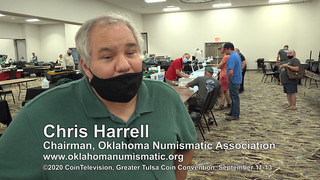 The Oklahoma Numismatic Association held the Greater Tulsa Coin Show during the Covid Virus Pandemic. Masks were worn and social distancing prevailed. Hear what was involved to get this convention going from officials in the club.
The Oklahoma Numismatic Association held the Greater Tulsa Coin Show during the Covid Virus Pandemic. Masks were worn and social distancing prevailed. Hear what was involved to get this convention going from officials in the club.
An excerpt of the video is available for viewing on the Coin Television YouTube Channel at:
https://youtu.be/shOsS62Klcc
SUPPORT THE 2021 SILVER DOLLARS!
Legislation calling for 2021-dated silver dollars has passed in the U.S. House of Representatives! But it's still not a law yet - the next hurdle is the U.S. Senate. The Senate bill is S-4326. There are only days left in the current Congress, so please reach out to your Senators' offices to encourage their support for this bill! -Editor
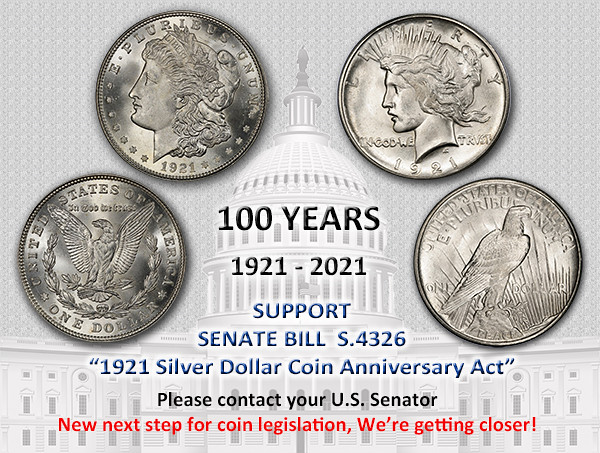
To read the Coin World article, see:
House approves 2021 Morgan and Peace dollars
(https://www.coinworld.com/news/us-coins/house-approves-2021-morgan-and-peace-dollars)
To read the earlier E-Sylum articles, see:
SUPPORT THE 2021 SILVER DOLLAR COMMEMORATIVES!
(https://www.coinbooks.org/v22/esylum_v22n30a14.html)
1921 SILVER DOLLAR ACT GAINS SPONSORS
(https://www.coinbooks.org/v22/esylum_v22n45a16.html)
1921 SILVER COIN ANNIVERSARY ACT SUPPORT SOUGHT
(https://www.coinbooks.org/v23/esylum_v23n12a17.html)

NOTES FROM E-SYLUM READERS: SEPTEMBER 27, 2020
Rubin's "Catalogue of Catalogues"
George Kolbe submitted this note offering a teaser of the upcoming Kolbe & Fanning numismatic literature sale. Thanks! -Editor
"Yes, wonderful things!"
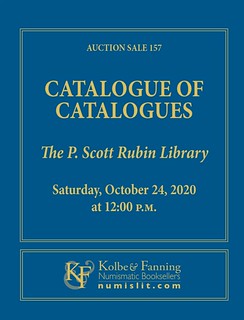 Early last week, David Fanning emailed a layout proof of Kolbe & Fanning Sale 157, with the following admonition: "Just focus on big stuff at this point as we're going to the printer today." Finding nothing to critique, I nonetheless kept looking through the catalogue in the following days, bringing to mind Howard Carter's famous response to Lord Carnarvon's query about his impression of the first glimpse of the contents of Tutankhamun's tomb in the Valley of the Kings.
Early last week, David Fanning emailed a layout proof of Kolbe & Fanning Sale 157, with the following admonition: "Just focus on big stuff at this point as we're going to the printer today." Finding nothing to critique, I nonetheless kept looking through the catalogue in the following days, bringing to mind Howard Carter's famous response to Lord Carnarvon's query about his impression of the first glimpse of the contents of Tutankhamun's tomb in the Valley of the Kings.
In our own little world, Philip Scott Rubin's "Catalogue of Catalogues" is chock full of wonderful things, particularly among his earlier American numismatic auction sales. The library was formed over half a century. This first installment of Scott's extensive collection, numbering in excess of 10,000 catalogues, is limited to 500 lots, and includes many highlights. You will enjoy perusing it, regardless of your numismatic affinities.
It should be mentioned that this comprehensive library of American numismatic sale catalogues was plumbed to its depths in terms of groundbreaking numismatic research, and that the wealth of such invaluable information now regularly encountered in the current generation of American coin auction sale catalogues is, in significant part, the result of Scott's wide-ranging analyses. Freely shared, with little regard to attribution, it is the measure of the man.
I had the pleasure of visiting Scott many years ago, and his library was indeed a sight to behold. He not only had the material, he mined it extensively for numismatic research. Every cataloguer and researcher of any note beat a path to his door over the years, and generations of collectors now benefit from that groundbreaking work. Now the next generations will have a chance to acquire Scott's treasured research materials for their libraries and collections. We'll look forward to the catalogue. -Editor
A Damaged 2008-D Hawaii State Quarter
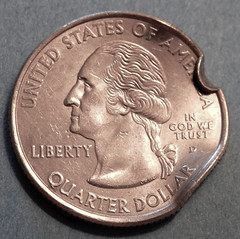
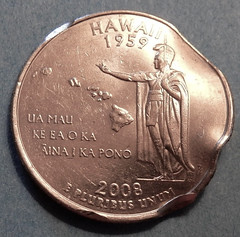
Error coin expert Fred Weinberg writes:
"That Hawaii Quarter in last week's E-Sylum is just a damaged coin - there are at least two very bad rim dings/cuts, - - that coin did not leave the US Mint looking like that.
"I'd say 'spend it', but it might be rejected a few times by younger cashiers."
Thanks. It sure is an odd-looking thing. I'm amazed that it fit well enough into the roll with other normal quarters. -Editor
To read the earlier E-Sylum article, see:
NOTES FROM E-SYLUM READERS: SEPTEMBER 20, 2020 : An Odd 2008-D Hawaii State Quarter
(https://www.coinbooks.org/v23/esylum_v23n38a12.html)
Kointains at Chase Manhattan Display
David Thomason Alexander writes:
"Might I add my half cents' worth to the recent recognitions of the E & T Kointainer? I first encountered these wonderful things while I was a struggling young collector in Miami Beach, Florida; not the ideal climate for preservation of coins in any metal. I corresponded with Dr. Epps and bought a lot of his product with wonderful results. I also marvelled at their use in the Chase Manhattan Coins of the World display in Rockefeller Plaza, coins were exhibited "on the half shell" in the upright displays.
"When Chase brought in what one wag called an "inferior dreckerator" to totally revamp the display, other means were employed. As a fellow Past President of the Shelby County (Ohio) Coin Club, I applauded Bern Nagengast's heroic efforts to keep this marvelous product going."
To read the earlier E-Sylum article, see:
MORE ON E & T KOINTAINER COMPANY
(https://www.coinbooks.org/v23/esylum_v23n38a13.html)
More on Familie Penningen: Family Medals?
Martin Purdy of New Zealand submitted these thoughts on Bernard Olij's question about the term "Familie Penningen". Thanks! -Editor
Our Dutch colleague's question is an interesting one, as "penning" seems to cover a lot of ground in Dutch, and like most translation questions, the relationship is one-to-many (or many-to-many), and almost never one-to-one. My instinct in this case is to consider the "familie penningen" as private medals, but the expression "family medals" doesn't lend itself to Googling very readily, and even to a native English speaker's ear it could sound like a group of medals inherited from grandparents who saw military service, for example. Even "family-related medals" tends to describe medals awarded to different members of the same family, so a nice cover-all term is eluding me for the moment. I did notice an earlier edition of The E-Sylum carried an item on wedding or anniversary medals, which appear to be a subset of the same theme.
In the meantime, however, and this is kind of helping us stall for another week or so while we think about it some more, my wife's Dutch relations were planning a book tracing the family history in 2009 and one of the numerous members of the Twaalfhoven clan with an artistic bent created the "Twaalfhoven penning" - essentially a large-format art medal with symbols relating to the family and its spread around the world in recent generations. The large heart relates to the "green heart of the Netherlands" where the family has its origins, for example. I've never thought of trying to class it as anything other than a medal or an art medal, so I too will be interested in any further ideas readers may have.
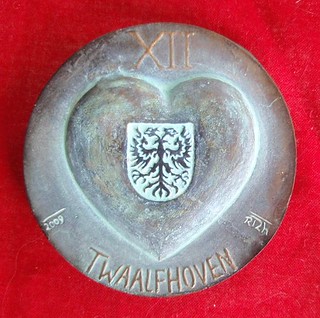
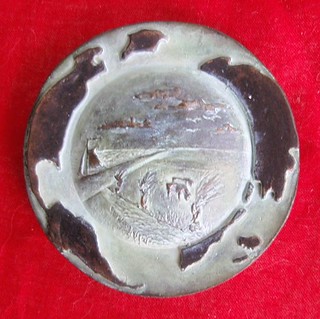
Here's a longer description of the symbolism on the Twaalfhoven penning that I wrote for a numismatic forum in 2010:
"To mark the publication (still forthcoming, I believe) of a book tracing the history of the Twaalfhoven family (my wife's relations, mainly in the Netherlands, but now spread far and wide), artist Rieneke Twaalfhoven produced the following medal:
"The obverse shows a heart with the double-headed eagle from the Twaalfhoven family crest, with the number XII above ("twaalf" in Dutch). According to the artist, XII brings present and past together, as when a clock reaches XII it has completed its cycle and begins again. At left is the date 2009 and at right the artist's cypher R12h.
"The reverse represents the origins of the family in rural Holland, with a representation of the continents expanding out from the "globe" in the centre (it is a flattened sphere, rising some 5 mm from the field of the medal), which is a reference to the fact that the family has now spread out world-wide.
"The medal is in bronze, 67 mm, 211 g, and is artificially aged. Production total to December 2010: 42. Each medal is hand-finished."
To read the earlier E-Sylum article, see:
NOTES FROM E-SYLUM READERS: SEPTEMBER 20, 2020 : Query: Familie Penningen
(https://www.coinbooks.org/v23/esylum_v23n38a12.html)
It's the Searching, Not the Finding
Tom Lovelace writes:
 "I find it interesting that Forrest Fenn's treasure has come up in the last couple of issues. By coincidence, I left the fires in California and headed out on my search for his treasure the day he died. I am 99% certain that I found where his treasure was, about 100' off of a forest service road in Montana in an amazingly beautiful place. However, I was not brave enough to become 100% certain. My location fits all of the clues, some of which are quite clever. Maybe on another trip, I will be braver. It is important to remember, that the purpose of Fenn placing his treasure was to get people outdoors and finding the beauty of all that is around us. For me, I found much treasure on my trip. I searched out all the local coin stores along my path and was most amazed by the store in Burley, Idaho on this trip. I also spent days in Yellowstone away from the crowds. I encourage others to search for their own treasure."
"I find it interesting that Forrest Fenn's treasure has come up in the last couple of issues. By coincidence, I left the fires in California and headed out on my search for his treasure the day he died. I am 99% certain that I found where his treasure was, about 100' off of a forest service road in Montana in an amazingly beautiful place. However, I was not brave enough to become 100% certain. My location fits all of the clues, some of which are quite clever. Maybe on another trip, I will be braver. It is important to remember, that the purpose of Fenn placing his treasure was to get people outdoors and finding the beauty of all that is around us. For me, I found much treasure on my trip. I searched out all the local coin stores along my path and was most amazed by the store in Burley, Idaho on this trip. I also spent days in Yellowstone away from the crowds. I encourage others to search for their own treasure."
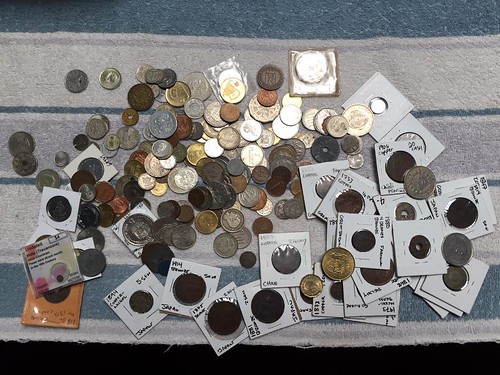
Great trip! Glad you stayed safe and made it back. Some got too caught up in the excitement of finding the treasure and weren't so lucky. The natural beauty of the outdoors is something many more of us should experience first hand. In my single days I did a lot of outdoor hiking in my area. It was delightful to be out in nature, and my most memorable excursions were when we were out in the snow or in a pouring rainstorm in the forest. A lot of people got out there following the treasure publicity, and most of them came back safely. That much is certainly a good thing. I hope people keep visiting, and in this Covid-19 era I understand a lot more people are out visiting the parks these days. Enjoy! -Editor
To read the earlier E-Sylum article, see:
LOOSE CHANGE: SEPTEMBER 20, 2020 : Guardian Article Questions Fenn's Treasure Hunt
(https://www.coinbooks.org/v23/esylum_v23n38a31.html)

MORE ON ENGRAVED CHARLES LINDBERG MEDALS
John Sallay submitted these notes in response to Harry Waterson and Steve Bishop's items on engraved Charles Lindberg medals. Thanks! -Editor
I have two different varieties of the Lone Eagle medal which were used for awards in Bronxville, New York, just outside of New York City. At first, a regular issue medal was simply hand engraved with the recipient's name and year of issue, along with the name of the school and the reason for the award. Then apparently, after a few years of all that hand engraving, the school had the Medallic Art Company create a new reverse die with all of the repetitive verbiage struck, so that only the name and date needed to be engraved.
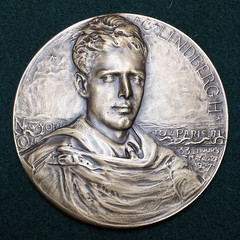
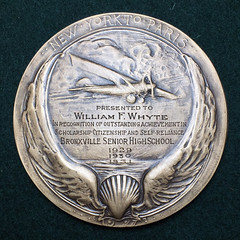
Lindberg Medal Type I: Fully Hand Engraved (Image courtesy John Sallay)
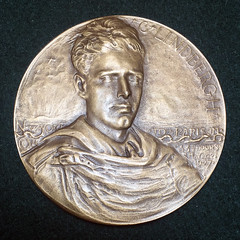
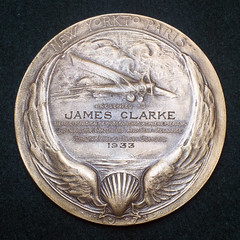
Lindberg Medal Type II: Partly Hand Engraved (Image courtesy John Sallay)
Although I haven't seen other examples of either of these varieties, except for your piece shown in the E-Sylum query, there should be others kicking around as there were 35 awarded in 1935 alone. Here's a snippet with some background on the medal from the Bronxville Press of June 14, 1935:
"Chambers Presents Lindbergh Medals Award For Outstanding Achievement And Citizenship; Given 35 Pupils. At an assembly of the junior and senior high schools last Wednesday morning, Jackson Chambers, president of the Gramatan National Bank, awarded Lindbergh Medals to twelve members of the junior high school and to twenty-three members of the senior high. Mr. Chambers has donated the medals to the school annually since 1927. Established eight years ago by Mr. Chambers, the Lindbergh Medals represent one of the highest recognitions of merit which the school offers. They are awarded on the basis of student and faculty judgment, and represent outstanding achievement in the fields of scholarship, self-reliance and citizenship. The twelve junior high awards went, this year, to the following: Margaret Eleanor Anning...(etc.) The 23 Senior High School students to receive the Lindbergh Medal from Mr. Chambers were Richard Bradshaw Angell...(etc.)"
I'll look forward to hearing the results of the broader research!
Lindbergh/Bowes Medal Struck by Whitehead & Hoag
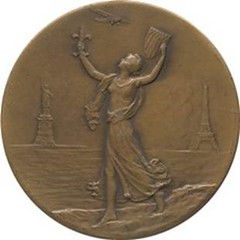 Regarding the Lindbergh medallion by Julio Kilenyi engraved to Major Bowes,
Dick Johnson writes:
Regarding the Lindbergh medallion by Julio Kilenyi engraved to Major Bowes,
Dick Johnson writes:
"The medal was made by Whitehead & Hoag."
Thanks, everyone. -Editor
To read the earlier E-Sylum article, see:
ENGRAVED CHARLES LINDBERGH MAJOR BOWES MEDAL
(https://www.coinbooks.org/v23/esylum_v23n38a10.html)

2021 NEW YORK INTERNATIONAL CANCELLED
The New York International show planned for January 2021 has been cancelled. Here's the announcement. -Editor
Convention Announces Cancellation of January Convention
 The New York International Numismatic Convention Board of Directors, meeting
on September 23, sadly reached a decision to cancel the 49th annual edition of the
world and ancient specialty convention, which had been scheduled to be held at the
Grand Hyatt New York from January 8 through 17, 2021.
The New York International Numismatic Convention Board of Directors, meeting
on September 23, sadly reached a decision to cancel the 49th annual edition of the
world and ancient specialty convention, which had been scheduled to be held at the
Grand Hyatt New York from January 8 through 17, 2021.
In a joint statement NYINC board president Mike Dunigan and bourse chairman Kevin Foley said, "In reviewing the unprecedented environment that would have been faced by our convention in light of the Covid-19 pandemic, including travel restrictions faced by foreign based participants, as well as quarantine requirements that would have affected the overwhelming majority of both our public and booth holding participants on arrival in New York, our board concluded that we simply had no viable option other than to cancel the 2021 NYINC."
They continued, "Moreover, our board concluded as well that in light of the serious threat of infection transmission that would have been faced by our participants, cancellation was the only responsible decision we could have reached."
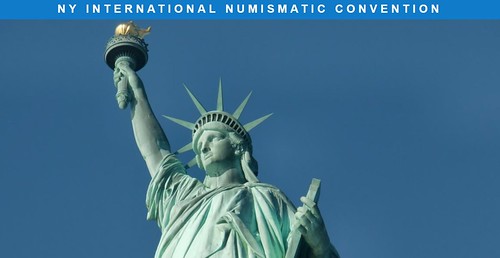
Foley added, "Moving forward, our 50th Annual New York International Numismatic Convention is scheduled for the Grand Hyatt New York over the dates January 7-16, 2022. I know that the NYINC occupies a special place on the overall numismatic calendar and in the lives of our participants. Our 2021 bourse was within a small handful of booths of once again being a total sellout. Our board and staff will look forward to seeing our many participants in 2022 for our 50th Annual NYINC, when we'll once again have eight full days of auctions, as well as a world and ancient specialty bourse where our attendees will be able to do business with booth holders from around the world that they will not see at any other event in the United States."
For more information, see:
http://www.nyinc.info/
THE ART WORLD LURCHES TO THE FUTURE
Global crises like the current pandemic have a way of accelerating the inevitable, in this case the shift of business of all types online. We've seen the effects in the coin market, with in-person events shutting down and being replaced in one form or another with online events. Coin auctions have had an online component for some time but the situation forced a total break from the past. It was time to adapt or die. As we've seen, the coin trade is still alive and well despite the (hopefully temporary) loss of many beloved in-person shows.
This article from Artnet highlights the recent changes in the high-end art world, which has some parallels to the coin market albeit in a different realm. Here's a short except - see the complete piece online. -Editor
When auctioneer Oliver Barker stepped into the Sotheby's London salesroom on June 29 to helm its first-ever global livestreamed auction, the whole art world was watching. The evening would show not only whether Sotheby's could pull off a major sale in the social distancing era but also whether the predictions were true that the art market was heading into a painful, prolonged period of correction.
Ahead of the marquee sale, Sotheby's put enormous energy—and cash—into creating a production that looked seamless and polished in front of the camera. It enlisted Chrome, a production company that specializes in covering extreme sports, to optimize its salesroom layouts and audio systems in London, New York, and Hong Kong for broadcast capabilities. It hired stylists to dress Sotheby's specialists so that their outfits popped against the color scheme of each city's unique "set."
By the end of the four-and-a-half-hour marathon sale, Sotheby's had managed to pull in $363.2 million—including $84.6 million for a triptych by Francis Bacon. It was almost 5 a.m. in London when the cameras turned off and Barker left the rostrum. On three continents, staff descended from their raised platforms, stepped over tangles of black wires, dodged the AV crew members, and breathed a heavy sigh of relief. The auction had come out smack in the middle of well-managed presale expectations.
This round of summer sales—rescheduled from their traditional May dates—was essential for the optics of the market, if not a cure-all for its bottom line. The Big Three auction houses (Sotheby's, Phillips, and Christie's) generated a combined $825 million. That was enough to reassure a jittery sector—but it was a far cry from the $2 billion made during last year's marquee May auctions. (The success was also extremely well orchestrated: both Sotheby's and Christie's lined up guarantees for at least half the works in their sales.) As Christie's CEO Guillaume Cerutti hopefully put it, one of the biggest results of his major summer auction was "to give confidence to our clients."
Confidence, of course, was key at that critical moment—these were the first sales of a new era. Now comes the hard part: adapting for the long haul.
See the full article for five key predictions of where the market goes from here. I think we'll see a lot of the same in the numismatic market. Here's one more excerpt on the scale of the changes. -Editor
"In all my years in the art market, there has never been an external event that forced such immediate change," said David Norman, Phillips chairman of the Americas. "Business as usual went right out the window."
Art-market veterans said the sector has never faced a challenge on the scale of this one—not when Japanese buyers disappeared from the high-flying Impressionist market in the 1990s, not during the first Gulf War, not in the wake of the September 11 terrorist attacks, and not in the aftermath of the 2008 global financial crisis.
Some of the immediate changes made as a result—like the permanent elimination of almost all splashy and expensive catalogues, the migration of sales online, and the collapsing of departments and categories—were in fact a long time coming. Other, less predictable ones, like the deep cutbacks on entertainment, dining, and travel, as well as the significant layoffs, will change the way the business functions for at least the foreseeable future, for better or worse.
To read the complete article, see:
‘Business as Usual Went Right Out the Window': How Lockdown Forced Auction Houses Into the Future—for Good
(https://news.artnet.com/market/covid-19-auction-houses-intel-report-2020-1909853)

VOCABULARY TERM: MULTIPLE BLANKING
Dick Johnson submitted this entry from his Encyclopedia of Coin and Medal Terminology. Thanks. -Editor
Multiple Blanking. The process of producing several blanks with a single stroke of the blanking press. A multiblanking head is required with a matching plate containing the same number and pattern of openings as the number and pattern of blanking punches. Such multiple blanking is highly suitable for coin blanks of thin gauge metal and small size blanks, as under one inch diameter.
The first multiple blanking had two blanking heads, and was called dual blanking. History has not recorded who developed this concept, but we do know that multiple blanking was done at the Royal Mint London by 1888. It was blanking silver shillings two at a time, and copper blanks – farthings and halfpence – five at a time.
As blanking presses developed, and became more powerful, additional blanking heads were added (with corresponding apertures in the blanking plate). The most modern multiple blanking presses can blank as many as thirty blanks with each cycle of the press. Wider strip is required and an elaborate blanking pattern is used. The advantage of multiple blanking is two fold: it lowers the cost of the blanks and slightly more blanks can be cut out of the strip (leaving as little as 30% to 35% unblanked, as skeleton scrap).
Multiple blanking can create a number of errors from imperfect advancement of the rolled strip. Also portions of the skeleton scrap have been inadvertently struck, these mint errors are unusual shape. The most dramatic of such is the BOW TIE, struck on a piece of scissel from the metal formed between two dual blanking dies.
`Leonardo da Vinci's drawing (circa 1500) for a proposed press had, in effect, a blanking and a striking press back-to-back. Perhaps it could also do double blanking on the same strip (since these were completely separate of one another da Vinci could be credited with the concept, despite the fact there is no record this press was ever built). See blanking.
As far as I know, this is still a standard part of the coin-making process around the world today. So much so that it's very hard to imagine a world where coin blanks were cut individually. The historical perspective is important - everything we do or use today was discovered or invented by people in the past trying to do their jobs better/faster/cheaper. -Editor
To read Dick's related earlier E-Sylum article, see:
THE HISTORY OF COIN PRESSES
(https://www.coinbooks.org/esylum_v07n40a03.html)
Looking for the meaning of a numismatic word, or the description of a term? Try the Newman Numismatic Portal's Numismatic Dictionary at: https://nnp.wustl.edu/library/dictionary
Or if you would like a printed copy of the complete Encyclopedia, it is available. There are 1,854 terms, on 678 pages, in The Encyclopedia of Coin and Medal Technology. Even running two a week would require more than 19 years to publish them all. If you would like an advance draft of this vital reference work it may be obtained from the author for your check of $50 sent postpaid. Dick Johnson, 139 Thompson Drive, Torrington, CT 06790.
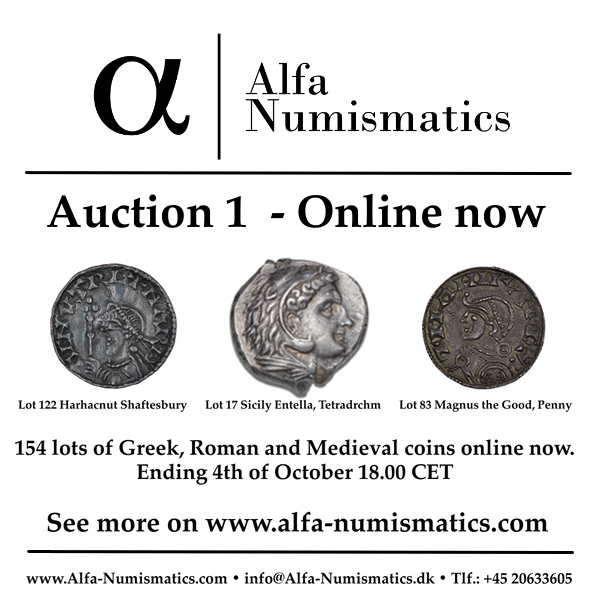
HERBERT VON SEGGERN (1856-1957)
John Lupia submitted the following information from the online draft of his book of numismatic biographies for this week's installment of his series. Thanks! As always, this is an excerpt with the full article and bibliography available online. This week's subject is Philadelphia dealer Herbert von Seggern of Keystone Coin and Stamp Company. -Editor
Numismatist Herbert Von Seggern lived to be 101!
Herbert von Seggern (1856-1957), was born on February 3, 1856 in Germany.
In 1911, he began trading as Keystone Coin and Stamp Company, 708 Chestnut Street, Philadelphia. Seggern printed FPL's which today are very scarce in the literature dealer market for current collectors. He is so scarce that he is not even listed in Remy Bourne's Fixed Price Lists, Vol. II.

Seggern's advertisement in the Philadelphia Inquirer, Sunday, September 22, 1912, page 42
Seggern's advertisement in The Numismatist, January (1913) : 50
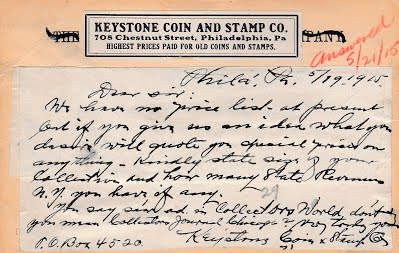
Seggern's recycled postal card dated May 19, 1915 covered with three paste overs on this side and one on the other was a common way coin and stamp dealers saved money mailing to clients buying old cards in large batches that were no longer any use to those who had originally printed and issued them. This card replies to an inquiry about a stamp price list, which Seggern tells is not ready at present.
He died on July 14, 1957. He was buried on July 16th at the Mount Peace Cemetery, Philadelphia, Pennsylvania.
To read the complete article, see:
SEGGERN, HERBERT VON
(http://www.numismaticmall.com/numismaticmall-com/seggern-herbert-von)
HARVEY STACK'S NUMISMATIC FAMILY, PART 79
The latest article in Harvey Stack's blog series wraps up the year 1979. -Editor
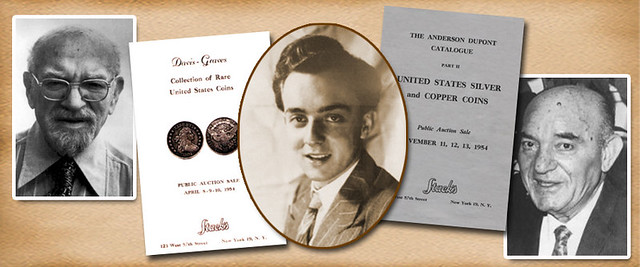
In the fall and early winter of 1979 we continued to present public auctions that offered a wide variety of numismatic items. Just after Labor Day, we offered a large, specialized collection of high quality and rare U.S. colonial coins formed by Donald S. Fleishcher. Don Fleishcher was well known in the numismatic clubs in the Metropolitan area as he had worked for decades with collectors who were centralized around New York. The friendships he had developed while collecting resulted in many specialists and well known numismatists participating in his sale, and it was a talked about event for months after. The sale contained hundreds of lots of colonial coins and currency, along with some classic early American issues to support the offering. It was a great opportunity for collectors in this field.
Martin F. Kortjohn, another great numismatist, had unfortunately passed away this year. His family awarded us the sale of his extensive collection, which yielded 1,235 lots of outstanding and quality coins of the United States. Martin was a dedicated numismatist, who had collected for well over four decades. Almost weekly he met with a number of friends, including Harold Bareford, Ed Hessberg, Vernon Brown, and Ray Gallo at Stack's, where they discussed coins, showed their latest acquisitions to each other, and traded duplicates. He had been extremely active in starting local coin clubs like the Bronx Club and the New York Metropolitan Club. Martin also served on many committees for the ANA and was Chairman of the Annual Numismatic Association Convention, held in New York in 1952. He played a great role in developing new collectors. The October 1979 auction catalog for his collection was an important source for tracing pedigrees, as many of the coins he acquired in his decades of collecting were bought from name sales where old timers were selling their collections.
Our 1979 auction season closed out with our December sale, which featured, a group of outstanding consignments which we had gathered during the summer and fall. We wanted to be sure we get them to market, as the sudden collapse of the silver market (almost 80% of the value) a few months earlier was beginning to affect numismatic prices. It was a very hard market to predict, as all the speculation in silver and the value that had been lost in the "great drop," had an effect on other precious metals, including gold. As the year came to an end, Stack's had to help collectors who had big losses due to silver speculation make sense of the market and cope with their losses. Despite this, it was a very successful and gratifying year for everyone at Stack's as we continued to work with collectors to help them build their collections and also to bring to market collections of all sizes and types, when it was time for those items to move on to another generation.
To read the complete article, see:
Harvey Stack Remembers: Growing up in a Numismatic Family, Part 79
(https://www.stacksbowers.com/News/Pages/Blogs.aspx?ArticleID=harvey-stack-remembers-part-79)
To read the earlier E-Sylum article, see:
HARVEY STACK'S NUMISMATIC FAMILY, PART 78
(https://www.coinbooks.org/v23/esylum_v23n37a21.html)
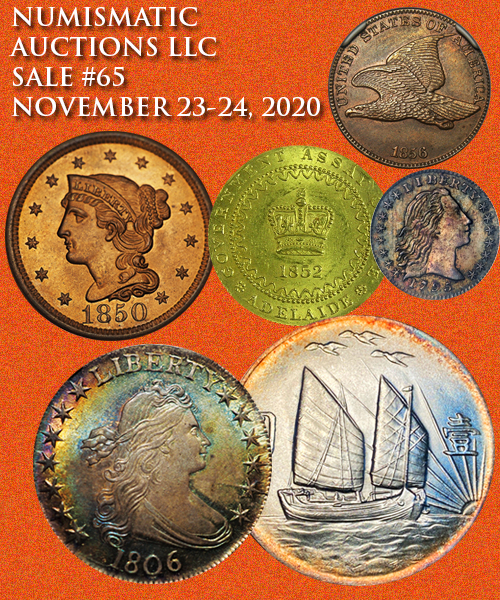
JIM BISOGNANI REMEMBERS ED LEVENTHAL
Earlier this month Jim Bisognani posted a nice remembrance of Boston dealer Ed Leventhal on the NGC site. Here's an excerpt. -Editor
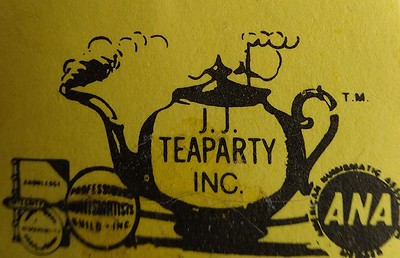
I fondly remembered one of my early and lifelong mentors, Ed Leventhal — "Mr. J.J. Teaparty" — who recently passed away. My dealings with Ed and the Boston coin shop J.J. Teaparty began 37 years ago, almost to the day, as it was just before Labor Day in 1983 that I first met Ed and saw in person that iconic simmering teapot hanging out front of the shop's Bromfield Street location.
I wasn't dealing much in coins back then, but I did have a small collection of US and foreign coins. Just before noontime on that fateful Friday, I put together a handful of better coins, which were expendables, that I calculated to be worth $500 or more. The key to this group was a nice, red Proof Indian Cent.
My wife and I took to the road from Portsmouth, New Hampshire to visit a few well-known coin shops in Wakefield, Massachusetts. Upon entering the first shop, I was offered $175 for the group. Dismayed, I visited another shop in town and was offered $145. I felt defeated and returned to the shop that offered me $175 and tried to persuade them to offer more — no luck.
I knew that the coins I had were worth around $500 or more, so before I left the shop, I asked if there were any other coin shops around. The dealer shot back, "If you want to battle the Boston traffic, you could try J.J. Teaparty on Bromfield Street. They might offer you a bit more. They are open until 5 p.m."
As it was after 3 p.m., I told the Mrs. that we better head to Boston. We pulled into Malden Station and took the Orange Line "T" to Haymarket and headed up to Bromfield Street. Upon being "buzzed" into the quaint and somewhat confining shop, I was greeted by Ed. We exchanged pleasantries, and he asked what he could do for me.
I then proceeded to pull out the handful of coins that I wanted to sell from the red 2x2 box that held them. Ed took the coins and carefully examined them. He referred to the Greysheet on a few of the US coins and then pulled down another catalog for the world coins. Ed then totaled up the numbers and said, "I will pay you $680." In response, I said, "I can't believe it!" Ed replied, "What, not enough?"
I smiled broadly, and said, "I have to tell you this: I just visited a few dealers in Wakefield and was offered $145 by one and $175 by the other." Ed blurted out, "For all of this?" Then Ed smiled, scratched his head and said, "Well, maybe I'm paying you too much." We both chuckled. I then said, "If I am ever in a position to do more business, I will come here." Ed thanked me and noted, "That is the way we try to do business."
To read the complete article, see:
Jim Bisognani: Early Fall Surprises
(https://www.ngccoin.com/news/article/8540/)
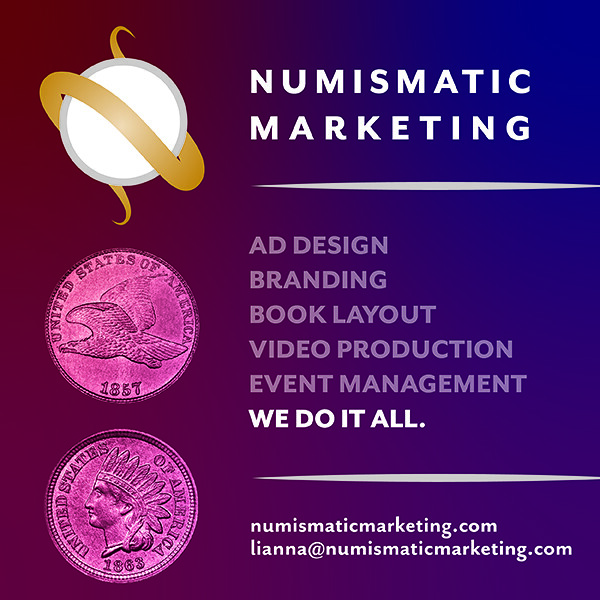
ARTICLE PROFILES GROVER CRISWELL
This article from the St. Pete Catalyst profiles the colorful life of flamboyant dealer and author Grover Criswell. Here's an excerpt - be sure to read the complete article online. -Editor
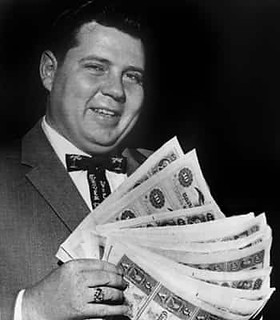 At 25, he was the youngest elected mayor in American history. He ran for the U.S. House of Representatives in 1962, as a Democrat, and lost to Bill Cramer. Criswell enjoyed saying that President John F. Kennedy offered him directorship of the U.S. Mint, and he turned it down to make a bid for Congress.
At 25, he was the youngest elected mayor in American history. He ran for the U.S. House of Representatives in 1962, as a Democrat, and lost to Bill Cramer. Criswell enjoyed saying that President John F. Kennedy offered him directorship of the U.S. Mint, and he turned it down to make a bid for Congress.
At Criswell's Money Museum, you could ogle whale tooth money ("Used to buy wives in the Fiji Islands!"), World War I-era German wooden dollars, rai stone currency from the Island of Yap and, of course, examples of that Confederate "funny money" from Criswell's own, extensive collection. An actor in full Confederate military dress greeted you at the entrance.
"The museum," believes Criswell's brother Clarence, 84, "just never had enough traffic to pay the overhead. That happens. It was kind of a nifty place, if you liked to look at money."
Grover Cleveland Criswell Jr. was, above and beyond his addiction to publicity, a serious collector and scholar. When he died of a heart attack in 1999, at age 65, he had served on the Board of Governors of the American Numismatic Association for 22 years, including a two-year term as president.
"I stand on the shoulders of giants, including his," says Pierre Fricke, author of Collecting Confederate Paper Money – Comprehensive Edition and other volumes. "He was a pretty significant leader. He was into Southern States money, too, and both Confederate and Southern States bonds, obsolete bank notes going back to the late 1700s. Those were his mainstays."
Criswell, Fricke says, "was the great marketer, the great promoter, of the stuff."
He was a familiar figure at coin shows and auctions, and through his mail-order collector business, where he had taken the name Colonel Criswell.
He and his brother were born and raised in Chicago, where their dad – a native Tennessean – operated a candy-making business (true to form, when Grover got a few drinks in him, he liked to tell folks that it was a front for Al Capone's bootleg whiskey racket).
The family relocated to Florida, buying a house on Pass-a-Grille Beach, in 1946. The brothers each graduated from The Citadel, a Charleston military college, earning degrees in history before returning to Florida.
"He and I started out together, late ‘40s, early ‘50s, doing coins and stamps together," younger brother Clarence explains. "Very early on, we did away with the stamps and started to do paper money."
From the office they shared in the back room of the Pass-a-Grille home, the Criswell brothers published Confederate And Southern State Currency, A Descriptive Listing in 1957, along with a followup volume. Grover would go on to write numerous books on Civil War-era currency; his identification and cataloging system is still the gold standard for the hobby today.
To read the complete article, see:
CREATEVINTAGE ST. PETE: The Mayor, the Colonel, the ‘richest man in the world'
(https://stpetecatalyst.com/vintage-st-pete-the-mayor-the-colonel-the-richest-man-in-the-world/)
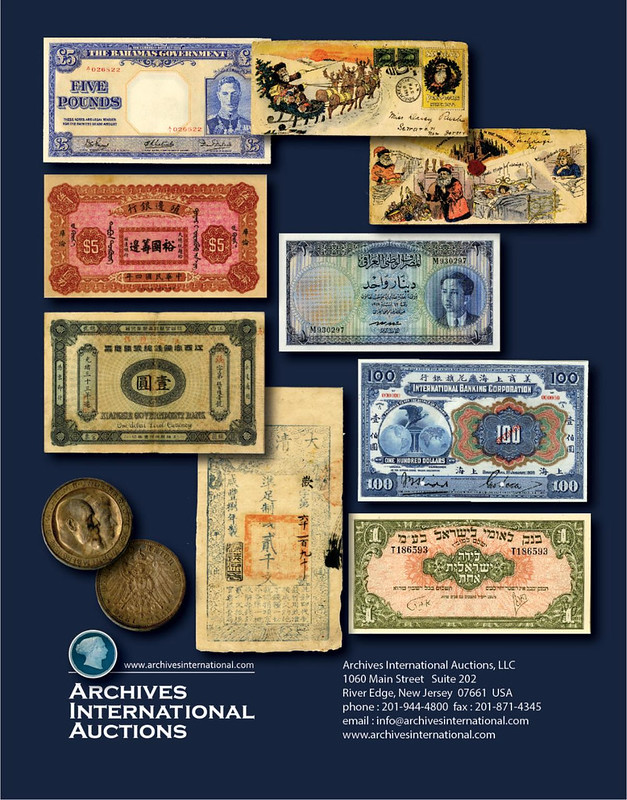
PHILADELPHIA MINT WORKING OVERTIME
The Philadelphia Inquirer published an article about how Mint employees are working overtime to alleviate the coin shortage. Here's an excerpt - see the complete article online. -Editor
At the Philadelphia Mint — the nation's largest producer of coin currency — 14 presses, each producing 750 coins a minute, are running seven days a week to compensate for the pandemic-caused coin supply problems that turned quarters, nickels, and dimes into rare commodities.
"I've never seen anything like this in the past," said a veteran Mint worker who maintains the coin presses and asked not to be named because he was not authorized to speak publicly.
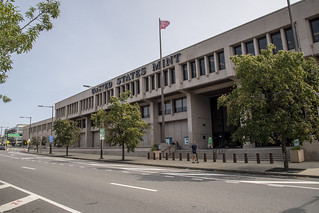 During each two-week pay period, he said, "I'm putting in about 30 hours' overtime."
During each two-week pay period, he said, "I'm putting in about 30 hours' overtime."
The problem isn't a lack of coins, the Federal Reserve said, but a lack of circulation.
When the pandemic shut down businesses and financial institutions, the normal exchange of coins seized up. Even since reopening, concerns about cash as a COVID-19 spreader caused some businesses to insist on card-only transactions, despite Philadelphia's banning such restrictions.
The pandemic has also accelerated trends toward online shopping, Kumar said, where no coins change hands. The result: too much of the nation's $48 billion in circulating coins is sitting stagnant.
Denver's and Philadelphia's facilities combined are producing more coins than they have in 20 years, aiming to produce 1.65 billion coins monthly through the rest of the year.
The Federal Reserve has capped the volume of coins it is distributing to the nation's banks and credit unions to spread out change more evenly, but it would not estimate when coin circulation would get back to normal.
Presses running on weekends at the Mint have become the new norm. Coin dies are quickly worn out by the relentless pace.
"Employees have essentially been working seven days per week for three months," said Chris Rapcziewicz, president of American Federation of Government Employees Local 1023, which represents about 300 Philadelphia Mint workers.
To read the complete article, see:
The coronavirus has caused a coin shortage, and Philly's Mint is working overtime to make up for it
(https://fusion.inquirer.com/news/coin-supply-circulation-change-mint-philadelphia-cashless-20200921.html)

ALFA NUMISMATICS AUCTION 1 CLOSES OCTOBER 4, 2020
Alex Jensen recently started Alfa Numismatics and will soon be holding his first auction sale. Here's the announcement. Good luck with your bidding! -Editor
Alfa Numismatics Auction 1 closes 4th of October 2020.
New to the numismatic market, more than 154 lots of ancient Greek, Roman and European medieval coins will be auctioned off in the inaugural online-only auction for the newly established numismatic auction house, Alfa Numismatics, on Sunday the 4th of October 2020.
Alex Jensen of Alfa Numismatics said: "Our first auction has a truly wide variety of coins from the ancient and medieval worlds. These coins give both the seasoned collector and those new to the hobby of numismatics a fascinating insight into ancient and medieval coinage. We firmly believe that there will be interesting coins for every collector and wallets"
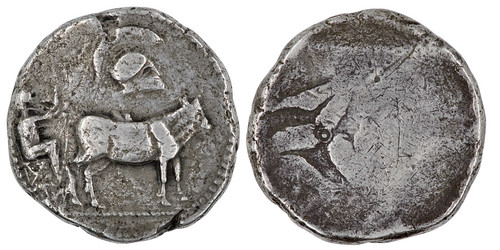
Pedigreed Thraco-macedonian Dodecadrachm
The selection of 54 ancient Greek lots is highlighted by a dodecadrachm minted by the Thraco-macedonian tribe of Derrones in circa 480-465 BC. It depicts an ox cart driven by a man on the obverse and a triskeles of human legs on the reverse. The Derrones, known only from their coinage, probably inhabited inland in the Paeonian region (present day North Macedonia). Like other Macedonian tribes they were quick to imitate the minting of Abdera. The unusual heavy denomination, usually a sign of export, was used for trade or perhaps for paying tribute to the Persian Empire. Lot 18, Estimate 1500€
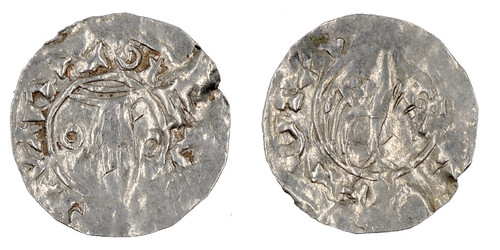
Bohemian denars
The auction has five extremely rare Bohemian including an extremely rare Adalbert, Bishop of Prague 992-994, obol with depiction of hand of providence descending from clouds on the obverse and an arching bird on the reverse.
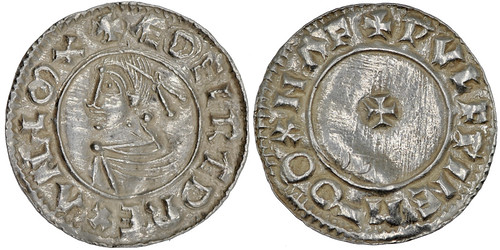
Rare Aethelred II penny
Lastly, of the 40 Anglo Saxon and Norman coins the auction contains, there is also an extremely rare Aethelred II Intermediate Small Cross (ISC) from the Oxford mint. The Aethelred ISC type is extremely rare and it was only struck for a short period of time at the following south western mints: Barnstaple, Gloucester, Ilchester, Malmesbury, Oxford, Wilton, Winchcombe, Winchester, and Worcester. Lot 104. Estimate 1500€
Bidders will have the opportunity to bid for all 154 lots online or by submitting bids by mail. The lots can be viewed, and bids submitted, online through www.alfa-numismatics.com.
Alfa Numismatics
Gammel Kongevej 163, postbox 486.
1850 Frederiksberg C
Denmark
Tlf.: +45 20633605
Email:
info@alfa-numismatics.dk
www.alfa-numismatics.com

LARRY NESS INDIAN PEACE MEDAL COLLECTION
Stack's Bowers will offer the Larry Ness Collection of Indian Peace Medals in November. Here's the announcement. -Editor
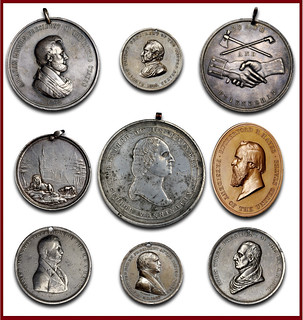 We are pleased to present the Larry Ness Collection of Indian Peace medals, one of the best and most complete Indian Peace Medal collections of all time. Ness had remarkable success acquiring the rare silver originals awarded to Native Americans, collecting a remarkable 36 examples, ranging from a First Size Thomas Jefferson through the extremely rare 1890 Benjamin Harrison, the latter with provenance to the original recipient. Bronze medals begin with John Adams and include important rarities of the later Oval series. Also showcased is a representative collection of French, Canadian, and British medals in silver and bronze, as well as a pair of very rare medals related to the Fur Trade.
We are pleased to present the Larry Ness Collection of Indian Peace medals, one of the best and most complete Indian Peace Medal collections of all time. Ness had remarkable success acquiring the rare silver originals awarded to Native Americans, collecting a remarkable 36 examples, ranging from a First Size Thomas Jefferson through the extremely rare 1890 Benjamin Harrison, the latter with provenance to the original recipient. Bronze medals begin with John Adams and include important rarities of the later Oval series. Also showcased is a representative collection of French, Canadian, and British medals in silver and bronze, as well as a pair of very rare medals related to the Fur Trade.
This sale was originally scheduled for March 2020 but was rescheduled for our November 2020 event, and promises to be a highlight among many important offerings. An edited, updated version of the sale catalogue will be prepared, and our online presentation of this collection reflects all of the edits.
To view all lots, see:
https://auctions.stacksbowers.com/auctions/3-OA9TV/november-2020-auction-the-larry-ness-collection-of-indian-peace-medals-lots-2001-2130
Here are some lots that caught my eye for various reasons. -Editor
Lot 2001: 1693 Louis XIV Felicitas Domus Augustae Medal
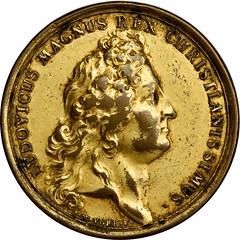
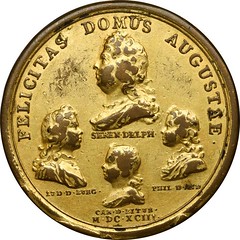
1693 Louis XIV Felicitas Domus Augustae medal. Copper, Gilt. Betts-Unlisted, types similar to Betts-75. Extremely Fine.
41.1 mm. 404.3 grains. Obverse signed I. MAVGER F. Obv: bust of Louis XIV, right. Rev: bust of the dauphin over those of his three children. Mellow golden gilt surfaces are reasonably intact for a worn medal, although the gilding is worn through on the highest points of the portrait reliefs on both sides and to a lesser degree on the tops of the letters of the legends. No serious marks or problems, though there is a bit of surface debris caked in places. Rim cuds on the reverse from 5:00 to 8:00. This was one of a series of medals struck to celebrate the prosperity of the Royal House. The first of this series, Betts-75 was officially presented to Native Americans, while some others are thought to have drifted into Native hands through unofficial channels. Part XVI of the illustrious Ford sales included two such medals in silver, though they were from different dies than seen here. As this has no manner of suspension, it was likely not presented to a Native American, yet it is a useful representation of those that were so used by King Louis XIV.
Provenance: Ex Stack's, January 2010, lot 6192.
To read the complete lot description, see:
1693 Louis XIV Felicitas Domus Augustae medal. Copper, Gilt. Betts-Unlisted, types similar to Betts-75. Extremely Fine.
(https://auctions.stacksbowers.com/lots/view/3-OAAF8/1693-louis-xiv-felicitas-domus-augustae-medal-copper-gilt-betts-unlisted-types-similar-to-betts-75-extremely-fine)
Lot 2002: George III and Queen Charlotte Medal
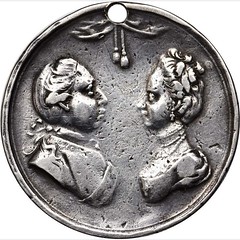
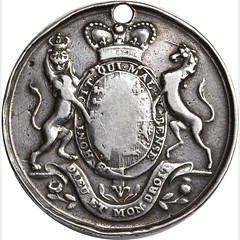
Circa 1761 George III and Queen Charlotte medal. Silver. Adams 11.2 (Obverse 1, Reverse B), Betts-440, Jamieson Fig. 10. Fine.
37.7 mm. 246.9 grains. Pierced for suspension. Unsigned dies. Obv: facing busts of the king and queen, drapery above. Rev: the royal arms and supporters. Light silver gray with some deeper patina in the recesses. A slight bend in the relatively thin flan is noted, as are a few scattered nicks and marks consistent with a medal worn in Native American context as is believed to have been the case with some of these marriage medals. The suspension hole is expanded from use, with the upper edge quite thin, but unbroken.
Of the 13 medals accounted for in John Adams' Census, nine are included in institutional collections leaving precious few for collectors. There are more specimens about, to be sure. One in Adams' own collection was acquired after he published, and this one also seems to have been unknown to him in 1999. This said, they are indeed rare and this piece has a couple of useful distinctions. First, it was clearly worn. The two Adams Collection specimens were much better preserved, and one was suspiciously so for a medal believed distributed to Native Americans. The Ford specimen was unpierced. This example is far less questionable as an issued medal. It is also from Adams' Reverse B, by far the rarer of the two. Adams noted in 1999 that just one of the 13 medals in his Census was from this reverse die, a medal in the Glenbow Museum. There is one other from the W.W.C. Wilson sale that is now in the ANS. Inexplicably, while it was plated in the Wilson sale with an apparently plugged hole, at the ANS it has an added suspension loop. This is a third example from this reverse.
Provenance: Ex Stack's Bowers Galleries, January 2013, lot 10108.
Rare piece - a marvelous used example. -Editor
To read the complete lot description, see:
Circa 1761 George III and Queen Charlotte medal. Silver. Adams 11.2 (Obverse 1, Reverse B), Betts-440, Jamieson Fig. 10. Fine.
(https://auctions.stacksbowers.com/lots/view/3-OAAFF/circa-1761-george-iii-and-queen-charlotte-medal-silver-adams-112-obverse-1-reverse-b-betts-440-jamieson-fig-10-fine)
Lot 2014: Hudson's Bay Company Indian Peace Medal
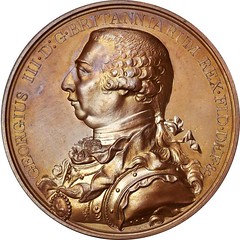
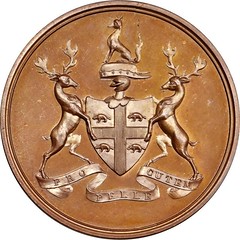
Undated (circa 1820) George III Hudson's Bay Company Indian Peace medal. Copper, Bronzed. Eimer-1120, BHM-1062, Jamieson Fig. 20. Choice Mint State.
48.0 mm. 867.3 grains. Obverse signed C.H.K. (C.H. Kuchler). Obv: older mantled bust of George III, left. Rev: arms of the Hudson's Bay Company. Rich chocolate brown surfaces with strong golden highlights at the rims that fade into soft golden green accents in the fields. Deeply prooflike with strong mirrors that contrast sharply with the satiny devices. Traces of soft violet are also noted on the obverse. Struck from a cracked reverse die as usual, the small series of breaks near 12:00 connecting the fox to the rim. A most handsome specimen.
Provenance: Ex Stack's Bowers Galleries, February 2015, lot 18.
Beautiful piece with strong obverse portrait. -Editor
To read the complete lot description, see:
Undated (circa 1820) George III Hudson's Bay Company Indian Peace medal. Copper, Bronzed. Eimer-1120, BHM-1062, Jamieson Fig. 20. Choice...
(https://auctions.stacksbowers.com/lots/view/3-OAAG0/undated-circa-1820-george-iii-hudsons-bay-company-indian-peace-medal-copper-bronzed-eimer-1120-bhm-1062-jamieson-fig-20-choice)
Lot 2060: 1841 John Tyler Indian Peace Medal
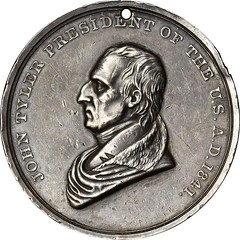
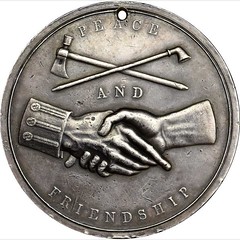
1841 John Tyler Indian Peace Medal. Silver. Second Size. Julian IP-22, Prucha-45. Extremely Fine.
62.3 mm. 1554.4 grains. Pierced for suspension as typical, with all piercings consistently positioned on the medals observed by us, both with respect to the obverse and reverse designs. Mostly deep gray silver with lighter gray high points that serve to accentuate the design features a bit. Soft blue iridescence in the fields on both sides. Another very handsome medal, this combining the desirable attributes of quality and clear evidence of having been issued and worn. Numerous small nicks are seen, as are small rim bumps, the largest being over THE on the obverse and an ideal identifier of this specimen. Initials are lightly and somewhat crudely cut into the right obverse field and appear to be "HSD" or "HSB." While elsewhere in numismatics "graffiti" of this nature is seen as a negative, on Peace medals it may allude to a past owner and perhaps the original recipient. As such, it is the writer's most favored type of "impairment" to discover on one of these medals. Even when it can't possibly lead to the identity of a specific human hand, it speaks to a degree of pride in ownership. These were never intended to be protected in cabinets of collectors and as such the signs that they were valued during their periods of use are different what might be used by numismatists.
The medals for John Tyler mark a change in the production methods for the Peace medal dies. Instead of hiring die-sinkers to engrave the dies directly, the Mint elected to use its new portrait lathe to cut the dies from a prepared model. This saved both time and expense. Between December 1842 and January 1843, the entire order of John Tyler medals in silver was delivered. This is reported to have been 60 in large-size and 100 each in the medium and small-size medals. It remains unknown how many of the medals were actually distributed, but, according to Prucha, more than 40% of the original mintage, by weight, was returned to the Mint and melted for use in making the James Polk medals. From the writer's survey of specimens, it seems that the medals may have been distributed in roughly equal numbers, as those located today are roughly the same in number for each size. Of this size, seven distinct medals have been accounted for, with three in the collections of the ANS, the Gilcrease Museum and the Jefferson National Expansion Memorial in St. Louis.
Provenance: Ex F.C.C. Boyd Estate; John J. Ford, Jr.; Stack's sale of the John J. Ford, Jr. Collection, Part XVIII, May 2007, lot 111; Stack's, January 2008, lot 7142.
Great medal. I agree that signs of use add to the appeal. -Editor
To read the complete lot description, see:
1841 John Tyler Indian Peace Medal. Silver. Second Size. Julian IP-22, Prucha-45. Extremely Fine.
(https://auctions.stacksbowers.com/lots/view/3-OAA8W/1841-john-tyler-indian-peace-medal-silver-second-size-julian-ip-22-prucha-45-extremely-fine)
Lot 2082: 1853 Franklin Pierce Indian Peace Medal

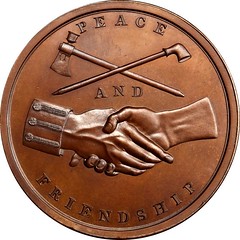
1853 Franklin Pierce Indian Peace Medal. Copper, Bronzed. First Size. Julian IP-32, var. Prucha-Unlisted. MS-66 BN (NGC).
76.5 mm. 3750.1 grains. A superb specimen of this very rare muling combining the original obverse for the issued Pierce medals with the second Peace and Friendship reverse, cut in 1846. Beautiful light mahogany patina with faint flecks of orange. Bold satin luster and really nice eye appeal. The obverse is essentially free of any marks save for a couple of microscopic spots, while the reverse has a slightly larger spot off the left index finger point, a small rim bump at the E of FRIENDSHIP and a couple of small marks in the upper field. This is a very rare muling of which we have only seen one other in our sales, that we recall. This one was in our Ford Sale, Part XVIII, and then in our January 2011 sale where the present owner bought it.
There was an example in the 1986 David W. Dreyfuss Collection sale, and one in Presidential Coin and Antique's sale #38 (May 1985). The latter was referenced as the sole auction appearance Carl Carlson was aware of in 1986. In the Presidential sale, Joe Levine commented that he was aware of only one other auction appearance, in the Kessler-Spangenberger sale in 1981. Levine was caught in the trap set by an overly overlapped auction plate, with most of the reverse covered. In fact, that was a different muling, the Pierce obverse paired with the pre-1846 Peace and Friendship reverse. While we have not exhaustively studied all sources for another example, it is worth mentioning a second time that Carlson and Levine knew of only the PCAC auction example. This could be the same one, or that one could be the Dreyfuss piece, but this one is not the Dreyfuss medal. There was no provenance recorded in the Ford notes, and the PCAC plate is of such low quality (an unfortunate standard of the time) that one can't be certain it's a different medal. Whatever the case, it is a great rarity, with perhaps only two or three known.
Provenance: Ex John J. Ford, Jr., Stack's sale of the John J. Ford, Jr. Collection, Part XVIII, lot 142; Stack's, January 2011, lot 6233.
Beautiful medal! -Editor
To read the complete lot description, see:
1853 Franklin Pierce Indian Peace Medal. Copper, Bronzed. First Size. Julian IP-32, var. Prucha-Unlisted.
(https://auctions.stacksbowers.com/lots/view/3-OAAO4/1853-franklin-pierce-indian-peace-medal-copper-bronzed-first-size-julian-ip-32-var-prucha-unlisted-ms-66-bn-ngc)
Lot 2110: 1891 Sioux Wars Medal
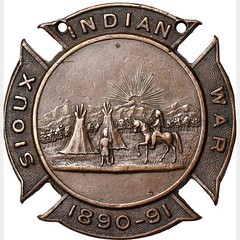
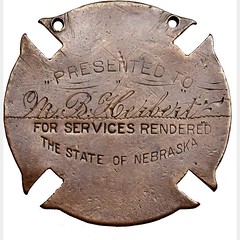
1891 Sioux Wars Medal issued by the State of Nebraska. Copper. Very Fine.
38.0 mm (drop only). The ornamental pinback hanger is lost. Deep chocolate brown surfaces, with a few light scratches and marks noted under magnification. As with the above example, the reverse is stamped with: PRESENTED TO / FOR SERVICES RENDERED / THE STATE OF NEBRASKA, and engraved to: M.B. Herbert, but without any rank or regimental assignment. Private Herbert was a member of Company H, 1st Regiment, according to a roster of recipients.
Another example of this very rarely seen artifact of the 1890-1891 Sioux Wars that included the Wounded Knee Massacre. Remarkably, though it has been formally acknowledged by resolution of both houses of the American Congress as worthy of "deep regret," at the time, 20 participants were awarded the Congressional Medal of Honor for their parts in the affair.
I'd never seen this before. Neat item. -Editor
To read the complete lot description, see:
1891 Sioux Wars Medal issued by the State of Nebraska. Copper. Very Fine.
(https://auctions.stacksbowers.com/lots/view/3-OAA7M/1891-sioux-wars-medal-issued-by-the-state-of-nebraska-copper-very-fine)
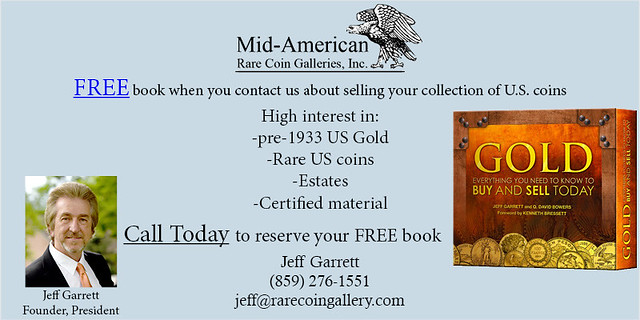
ARCHIVES INTERNATIONAL AUCTION 61
Here is the announcement for the October 4-5, 2020 sale by Archives International Auctions. -Editor
U.S., CHINESE & WORLDWIDE BANKNOTES, SCRIPOPHILY, COINS AND HISTORIC EPHEMERA TO BE OFFERED BY ARCHIVES INTERNATIONAL AUCTIONS AT PUBLIC AUCTION ON SUNDAY & MONDAY, OCTOBER 4 & 5, 2020
The auction will be held by Archives International Auctions at their offices in River Edge, N.J.
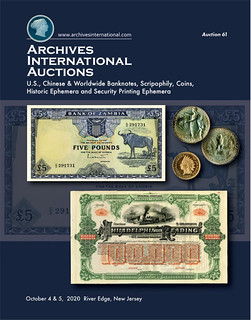 The October 4th and 5th, 2020 auction by Archives International Auctions will
consist of 1.356 lots offered over 2 days in 3 sessions beginning with Session 1, on October 4th
with 557 lots of Worldwide & Chinese Banknotes, Chinese Scripophily and World Coins.
Sessions 2 and 3 on October 5th features 799 lots of U.S. & World Scripophily, U.S. Banknotes,
U.S. Coins; Security Printing Ephemera and Historic Ephemera.
The October 4th and 5th, 2020 auction by Archives International Auctions will
consist of 1.356 lots offered over 2 days in 3 sessions beginning with Session 1, on October 4th
with 557 lots of Worldwide & Chinese Banknotes, Chinese Scripophily and World Coins.
Sessions 2 and 3 on October 5th features 799 lots of U.S. & World Scripophily, U.S. Banknotes,
U.S. Coins; Security Printing Ephemera and Historic Ephemera.
"During this difficult time period for our country and the world, we are striving to offer our clients and friends items of historical and collecting interest that have been off the market for decades and should command serious collector and dealer interest as well as add a small amount of enjoyment to everyone's lives", stated Dr. Robert Schwartz , President of Archives International Auctions. "We have included a wide variety or rare, interesting and desirable material to enhance the collections of every level of collector and dealer".
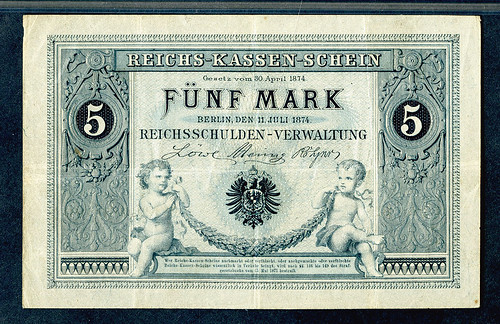
Lot 217
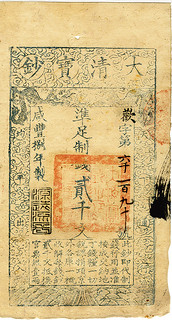 Included in the First Session on October 4th are consignments from numerous estates and
longtime collections with many items having never been offered previously at auction. The
auction begins with a selection worldwide notes with many highlights including an exceptional
1936, Bahamas Government, £5, P-12a banknote rarity that is PMG graded Choice Uncirculated
64, and is the only note out of 43 graded in Uncirculated condition; Bermuda is highlighted by a
number of desirable notes including a 1937, 10/- Shillings, P-9 in VF condition. The 13 Canada
lots are highlighted by a 1935, Bank of Canada, $20 , "English" issue in a nice PMG VF 25; China
features 69 lots with many high-grade notes as well as rarities, some possibly the finest known.
Auction highlights include a Ch'ing Dynasty, 1858, 2000 Cash note in PMG AU 55; a Kiangse
Government Bank, 1907, $1 issued note tied for the finest known that is PMG graded EF 40 out
of 36 graded; a 1905, Shanghai Branch, International Banking Corp, $100, P-S422s in PMG Gem
Unc 65; an extremely rare, 1915, Bank of Territorial Development, $5, P-574r in CU 63; and
dozens of other desirable and rare Chinese banknotes and scripophily. Germany is represented
by a superb 1874, Germany P-1, 5 Mark, Imperial Treasury Note , graded PMG Choice Very Fine
35, tied for the finest known; and an 1882, 5 Mark, P-4 graded PMG Very Fine 30; There are an
additional 98 lots of German Notgeld and inflation notes with many rare varieties and ending
with 8 different German States 3 Mark and 5 Mark coins, ca.1904 to 1919 in VF to Unc
condition. A 1706, War Repayment Bond for £210 from Her Majesty Queen Anne for the "War
Against France and Spain" is offered from the "John E. Herzog Collection"; Iraq is represented
by a trio of desirable notes including a 1950, National Bank of Iraq, 1 Dinar, P-29 graded Gem
Uncirculated 65 EPQ originally from the "Ruth Hill Collection"; Israel is highlighted by a 1952, 1
Pound, P-20a graded Superb Gem Unc 68 EPQ and is the highest and finest graded in the PMG
census. The Republica de Panama offering includes 2 extremely rare proof vignettes from the 5
Balboa and 10 Balboa, 1941 "Arias" issue and possibly the first time offered. The notes these
vignettes come from are extremely rare. Only 2 of each of these vignettes were found in 2002
and these are the only examples available. Zambia is represented by a 1964, Bank of Zambia, £5
Pounds, P-3a , graded Superb Gem Unc 67 PPQ and is by far the finest known; in addition
hundreds of additional banknotes, scripophily and historic ephemera is included in the auction.
Included in the First Session on October 4th are consignments from numerous estates and
longtime collections with many items having never been offered previously at auction. The
auction begins with a selection worldwide notes with many highlights including an exceptional
1936, Bahamas Government, £5, P-12a banknote rarity that is PMG graded Choice Uncirculated
64, and is the only note out of 43 graded in Uncirculated condition; Bermuda is highlighted by a
number of desirable notes including a 1937, 10/- Shillings, P-9 in VF condition. The 13 Canada
lots are highlighted by a 1935, Bank of Canada, $20 , "English" issue in a nice PMG VF 25; China
features 69 lots with many high-grade notes as well as rarities, some possibly the finest known.
Auction highlights include a Ch'ing Dynasty, 1858, 2000 Cash note in PMG AU 55; a Kiangse
Government Bank, 1907, $1 issued note tied for the finest known that is PMG graded EF 40 out
of 36 graded; a 1905, Shanghai Branch, International Banking Corp, $100, P-S422s in PMG Gem
Unc 65; an extremely rare, 1915, Bank of Territorial Development, $5, P-574r in CU 63; and
dozens of other desirable and rare Chinese banknotes and scripophily. Germany is represented
by a superb 1874, Germany P-1, 5 Mark, Imperial Treasury Note , graded PMG Choice Very Fine
35, tied for the finest known; and an 1882, 5 Mark, P-4 graded PMG Very Fine 30; There are an
additional 98 lots of German Notgeld and inflation notes with many rare varieties and ending
with 8 different German States 3 Mark and 5 Mark coins, ca.1904 to 1919 in VF to Unc
condition. A 1706, War Repayment Bond for £210 from Her Majesty Queen Anne for the "War
Against France and Spain" is offered from the "John E. Herzog Collection"; Iraq is represented
by a trio of desirable notes including a 1950, National Bank of Iraq, 1 Dinar, P-29 graded Gem
Uncirculated 65 EPQ originally from the "Ruth Hill Collection"; Israel is highlighted by a 1952, 1
Pound, P-20a graded Superb Gem Unc 68 EPQ and is the highest and finest graded in the PMG
census. The Republica de Panama offering includes 2 extremely rare proof vignettes from the 5
Balboa and 10 Balboa, 1941 "Arias" issue and possibly the first time offered. The notes these
vignettes come from are extremely rare. Only 2 of each of these vignettes were found in 2002
and these are the only examples available. Zambia is represented by a 1964, Bank of Zambia, £5
Pounds, P-3a , graded Superb Gem Unc 67 PPQ and is by far the finest known; in addition
hundreds of additional banknotes, scripophily and historic ephemera is included in the auction.
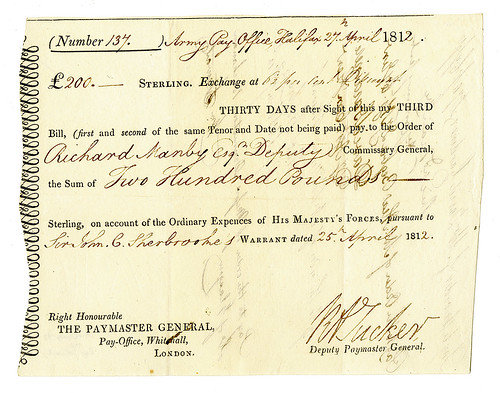
Lot 450
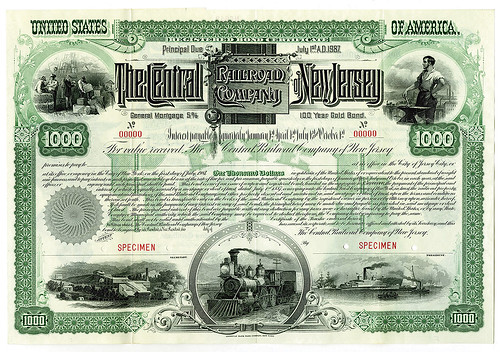
Lot 1024
Day 2, being held on Monday, October 5th in 2 sessions begins with 672 lots of U.S. and World Scripophily. The auction starts out with automobile and aviation bonds and shares followed by over 50 lots of banking, finance and insurance with many desirable and rare bonds and shares offered. Internet and technology companies include certificates from Apple , Intel, Yahoo!, and others; an extremely rare New York University "NYU" Specimen bond from 1936 is offered and is the only example we have seen; a rare 1888, Musical Hall Association of Honolulu stock certificate that is issued and uncancelled was known to host and entertain Hawaiian royalty as well as an extremely rare 1882 Hawaiian Government, $5000 Specimen Coupon Bond printed by ABNC is offered; a tasty. 1919, Coca-Cola Company, Specimen Temporary Stock Certificate, the earliest stock certificate from this historic company will be served at the auction; an extremely rare Imperial Japanese Government, 1924 Specimen bond by ABNC will be auctioned; a fashionable and rare "Gucci Group" 1999 specimen stock certificate will be sold; as well as dozens of other world certificates. Mining scripophily is highlighted by the well known "Gold Mining Company" 1888 stock certificate rarity with the map of the Mystic Mountains underprint; a Michigan mining rarity, an 1855 Stonington Mining Company is offered; an extremely rare if not unique Rockland County, NY, 1843, "The Sterling Company" Stock Certificate is offered with a large illustrated vignette of the mining and smelting facility that was dug up in an old estate; as well as dozens of other mining and Western related bonds and shares. There are 350 lots of Navigation and railroad bonds and shares offered with dozens of rare or unique certificates that have never been offered previously at auction including an 1888, Kansas City, Wyandotte and Northwestern Railroad Co., $1000 Specimen Bond beauty , as well as hundreds of exceptional stocks and bonds from automobiles to mining to railroads with every topic in between that should appeal to all levels of collectors and dealers.
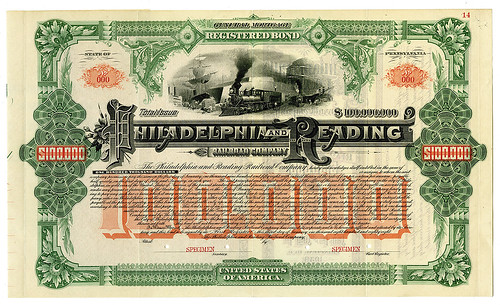
Lot 1112
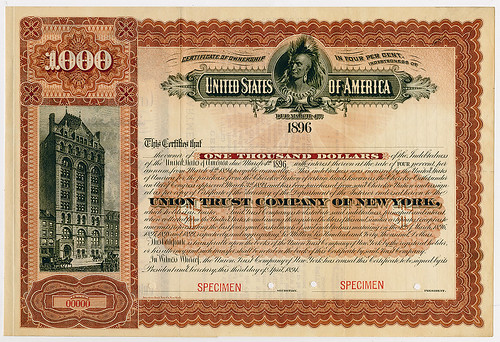
Lot 1237
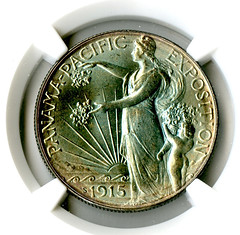 Session 3 scheduled on Monday, October 5th to begin no earlier than 5:00 PM EST begins with
U.S. Federal related Bonds, Loans and Documents highlighted by an 1894, $1000, U.S. Federal
"Cherokee Nation Bond" Specimen issued for the purchase of the lands known as the
"Cherokee Outlet" located in Oklahoma. U.S. Banknotes begins with U.S. Obsolete notes, Large
Type; National Banknotes; and, Depression Scrip followed by a fresh estate coin collection
beginning with and PCGS graded MS Unc Details, 1787 Fugio Cent , 4 Cinq; followed by 8
different Indian 1 Cent coins, all NGC graded, highlighted by an 1860, Proof 64, CAC; 1861,
PROOF 64*; an 1862, Proof 64 Cameo, CAC; an 1863, Copper Nickel Proof 66 Cameo ; an 1864
Proof 66 Cameo; and an 1869, Proof 65 RB Cameo. Additional highlights from the U.S. coin
section includes a superb 1915 S, 50 Cents, Pan Pac Commemorative PCGS graded Gold Shield
MS67+; and a 1798 $1 Large Eagle NGC graded AU 50. The autograph section includes historic
letters and documents including items signed by William Bowyer, an English Printer from 1740-
60; an Andrew Carnegie letter; a Robert F. Kennedy signed letter referring to his position on
Social Security signed 2 weeks before he was assassinated; a letter from Thomas J. Watson, Sr.
(IBM founder) regarding his friend George Eastman; and many other interesting and historic
items.
Session 3 scheduled on Monday, October 5th to begin no earlier than 5:00 PM EST begins with
U.S. Federal related Bonds, Loans and Documents highlighted by an 1894, $1000, U.S. Federal
"Cherokee Nation Bond" Specimen issued for the purchase of the lands known as the
"Cherokee Outlet" located in Oklahoma. U.S. Banknotes begins with U.S. Obsolete notes, Large
Type; National Banknotes; and, Depression Scrip followed by a fresh estate coin collection
beginning with and PCGS graded MS Unc Details, 1787 Fugio Cent , 4 Cinq; followed by 8
different Indian 1 Cent coins, all NGC graded, highlighted by an 1860, Proof 64, CAC; 1861,
PROOF 64*; an 1862, Proof 64 Cameo, CAC; an 1863, Copper Nickel Proof 66 Cameo ; an 1864
Proof 66 Cameo; and an 1869, Proof 65 RB Cameo. Additional highlights from the U.S. coin
section includes a superb 1915 S, 50 Cents, Pan Pac Commemorative PCGS graded Gold Shield
MS67+; and a 1798 $1 Large Eagle NGC graded AU 50. The autograph section includes historic
letters and documents including items signed by William Bowyer, an English Printer from 1740-
60; an Andrew Carnegie letter; a Robert F. Kennedy signed letter referring to his position on
Social Security signed 2 weeks before he was assassinated; a letter from Thomas J. Watson, Sr.
(IBM founder) regarding his friend George Eastman; and many other interesting and historic
items.
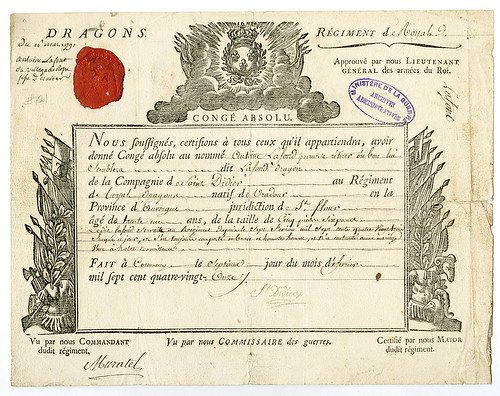
Lot 1324
Previews will be limited and by appointment only and we will be observing strict safety precautions including the wearing of masks and observing social distancing to protect our team as well as our guests. We will do our best to accommodate anyone who desires additional information and photographs. For questions, please call 201-944-4800 or email info@archivesinternational.com.
The online catalog for the October 4th and 5th auction is on Archives International Auctions' website and can be viewed via the Archives International live bidding platform. It can also be viewed as a Virtual Catalog or downloadable Sale 60 .pdf on our website. To pre-register for live internet bidding, log on to the Archives International Auctions website, at www.ArchivesInternational.com.
Archives International is now working on their late Winter and Spring 2020-21 auctions and are seeking quality consignments for future auctions or outright purchase including U.S. and worldwide banknotes, coins, stocks, bonds, stamps, postal history, historic ephemera, and autographs. To sell or consign one piece or an entire collection, please call AIA at (201) 944-4800; or e-mail them at info@archivesinternational.com.
You may also write to Archives International Auctions, at 1060 Main Street, River Edge, NJ 07661, U.S.A. To learn more about Archives International Auctions and the auctions planned for October 4th and 5th, 2020, log on to www.ArchivesInternational.com.

MARK T. RAY COLLECTION OF ENGLISH BANKNOTES
For more interesting banknotes at auction, see the Mark T. Ray Collection of English Banknotes to be auctioned by Spink in October. Here are some selections. -Editor
1. Bank of England £10 note dated 15th April 1912.
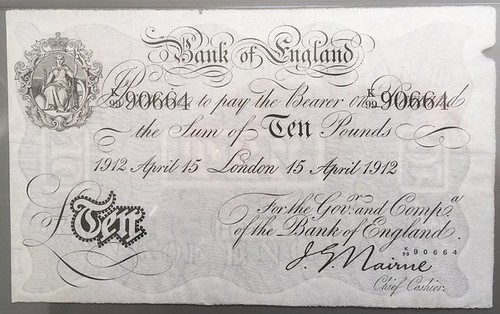
The Bank of England large size white notes are well known and popular with collectors, issued in various values until World War 2, and as £5 notes until 1956. Each issue had a unique serial prefix combination and specific date. This particular date was to become memorable as the date the RMS Titanic hit the iceberg and sank. £10 notes were high value and issued in limited numbers and pre-WWI examples are particularly rare. This is probably the only extant example of this date. Although unlikely to have been carried aboard, after the tragedy there were numerous claims on the Bank by survivors and relatives of those who perished regarding notes or life savings lost at sea. The Bank was sympathetic to the claims and paid out in full.
2. Treasury Bradbury £1 autographed banknotes signed by WWI Allied Army leaders.
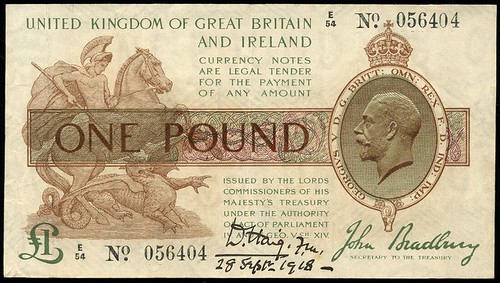
Four English Treasury Issue banknotes have been reunited after being signed by war leaders and personalities auctioned off for charity in 1918. Originally sold by a provincial newspaper to raise funds for starving prisoners of war, the notes are contemporary One Pound notes, three of which have original accompanying letters. The notes show manuscript signatures of Field Marshall Sir Douglas Haig, French General and Supreme Allied Commander Ferdinand Foch, French President Poincaré, and Admiral Beatty.
3. Abraham Newland £2 Bank of England banknote from 1800
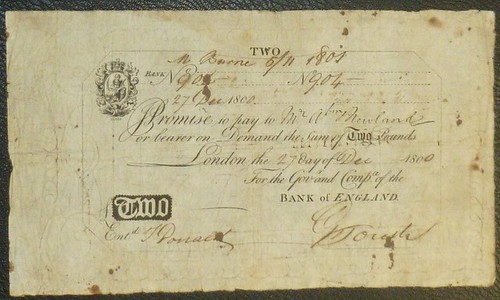
£1 and £2 notes were first issued by the Bank of England during the restriction period 1797-1826 to preserve gold stocks during the Napoleonic wars. Only a handful of £2 banknotes are now thought to have survived, and this one dated 1800 issued under the Chief Cashier Abraham Newland is a lovely example of such a survivor. The lot comes with a Bank letter from 1870 stating that the note was still outstanding, and a recent check of the appropriate ledger in the archive has confirmed it is still unpaid. That someone thought to keep the note in Victorian times having checked out its validity when it could easily have been cashed in makes it now an important item, although if presented to the Bank for payment now I am sure they would be delighted to encash it for its face value.
4. Guernsey Overprints from 1941 on One Pound Notes.
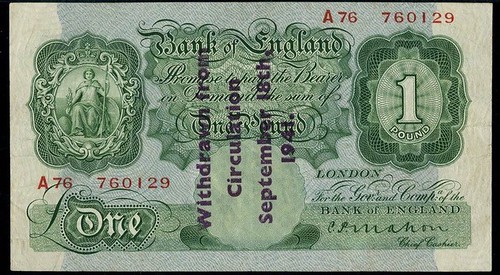
The Channel Islands being overrun by the German Army during World War II led to a shortage of small change on the island of Guernsey. To alleviate the difficulties faced by the islanders it was agreed to issue a quantity of coin, and an equivalent holding of UK notes by the local bank was set aside. Each of around 5000 withdrawn £1 notes were overstamped as shown, dated September or November 1941. Sometime after liberation these notes appeared on the collector market and have been popular ever since. All the serial numbers have been recorded, and the sale features a good selection.
The Mark T. Ray Collection of English Banknotes is to be auctioned by Spink, London on 8th October. Catalogues available online through https://www.spink.com/auction/20021 or at: https://d3ums4016ncdkp.cloudfront.net/auction/catalogue/20021/20021.pdf
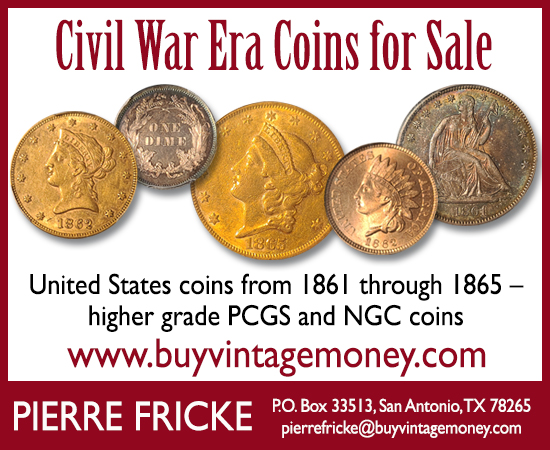
H. DON ALLEN EPHEMERA COLLECTION SELECTIONS
Here's a selection of items that caught my eye in the upcoming Geoffrey Bell sale of the Harold Don Allen ephemera collection. -Editor
Lot 79: General Electric Coin Advertisement Card
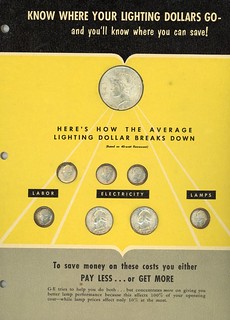
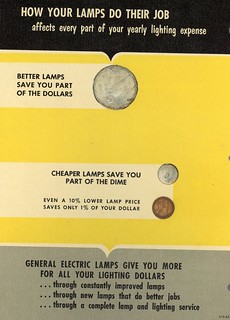
A truly interesting advertising by General Electric, the first seen by us. A coin display card in an envelope with "Here's Why Better G-E Lamps Give More For All Lighting Dollars" on the front. Inside the envelop a coin display card housing US uncirculated coins from 1956 1 x 1 cent; 6 x 10 cents, 2 x 25 cents &a 1922 US silver dollar. "Know where your lighting dollars go – and you'll know where you can save!" "To save money on these costs you either PAY LESS . . . or Get More". Don't miss this great piece of numismatic and advertisement history.
Very interesting item - I've never seen one of these before. -Editor
To read the complete lot description, see:
H. Don Allen Collection - General Electric USA Coin Advertisement Card
(http://auctions.gbellauctions.com/H-Don-Allen-Collection-General-Electric-USA-Coin-Advertisement-Card_i38480776)
Lot 481: Australian Historical Medal
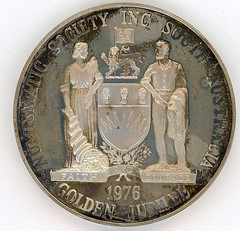
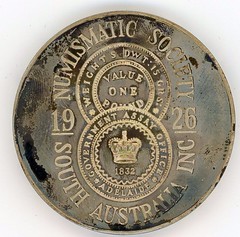
NUMISMATIC SOCIETY OF SOUTH AUSTRALIA, Golden Jubilee, 1976, in silver (45mm) by Pobjoy Mint (C.1976/11). Numbered 33 of only 100 on edge. With case of issue. Uncirculated.
To read the complete lot description, see:
H. Don Allen Collection - Australian Historical Medal
(http://auctions.gbellauctions.com/H-Don-Allen-Collection-Australian-Historical-Medal_i38481178)
Lot 834: Early Canadian Cheques
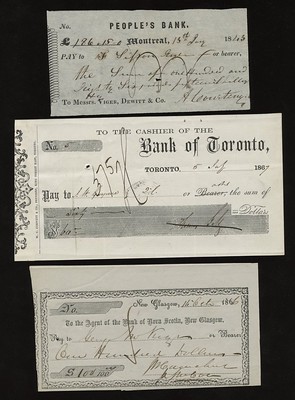 People's Bank (Banque du Peuple), Montreal, 1843; Bank of Nova Scotia, New Glasgow, 1866; Bank of Toronto,1867. The last appears to have been drawn by Thomas Galt (1815-1901), Chief Justice of Ontario, knighted 1888. He was a son of novelist and Canada Company official John Galt, a brother of Canada's first Finance Minister Alexander Tilloch Galt, and uncle of John Galt, President of the Union Bank of Canada, 1912-1922. Galt's cheque was negotiated through the Commercial Bank of Canada.
People's Bank (Banque du Peuple), Montreal, 1843; Bank of Nova Scotia, New Glasgow, 1866; Bank of Toronto,1867. The last appears to have been drawn by Thomas Galt (1815-1901), Chief Justice of Ontario, knighted 1888. He was a son of novelist and Canada Company official John Galt, a brother of Canada's first Finance Minister Alexander Tilloch Galt, and uncle of John Galt, President of the Union Bank of Canada, 1912-1922. Galt's cheque was negotiated through the Commercial Bank of Canada.
To read the complete lot description, see:
H. Don Allen Collection - Three Early Canadian Cheques
(http://auctions.gbellauctions.com/H-Don-Allen-Collection-Three-Early-Canadian-Cheques_i38481531)
Lot 847: British Financial Documents
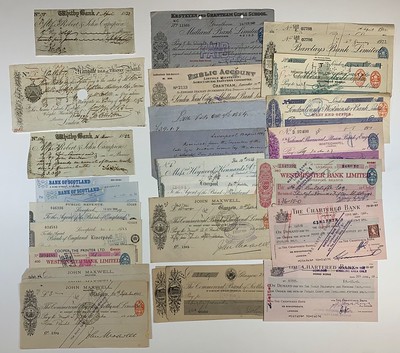 Margate Isle of Thanet Bank, draft, signed by Fr. Cobb & Son, 1797, central hole cancellation; Hand written promissory note, 1854, and receipt, 1863. Whitby Bank cheques, 1822, 1823. Cheques (24) 1856 to 1977, good mix of banks, moderate duplication. Also two 1968 cheques or drafts on the Chartered Bank, London, from Hong Kong and Osaka with interesting revenue stamps.
Margate Isle of Thanet Bank, draft, signed by Fr. Cobb & Son, 1797, central hole cancellation; Hand written promissory note, 1854, and receipt, 1863. Whitby Bank cheques, 1822, 1823. Cheques (24) 1856 to 1977, good mix of banks, moderate duplication. Also two 1968 cheques or drafts on the Chartered Bank, London, from Hong Kong and Osaka with interesting revenue stamps.
To read the complete lot description, see:
H. Don Allen Collection - British Financial Documents
(http://auctions.gbellauctions.com/H-Don-Allen-Collection-British-Financial-Documents_i38481544)
Lot 869: Early Bank Cheques, England and Australia
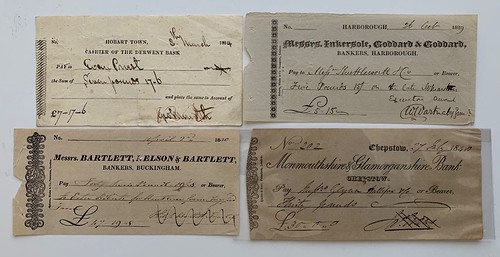
Inkersole, Goddard & Goddard, Harborough, 1829; Bartlett, Nelson & Bartlett, Buckingham, 1830; Monmouthshire & Glamorganshire Bank, Chepstow, 1848; Derwent Bank, Hobart Town, 1834.
Nice group. There are multiple lots of checks in the sale. -Editor
To read the complete lot description, see:
H. Don Allen Collection - Four Early Private Bank Cheques, England and Australia.
(http://auctions.gbellauctions.com/H-Don-Allen-Collection-Four-Early-Private-Bank-Cheques-England-and-Australia_i38481566)
Lot 876: Reversible Money Concept Notes
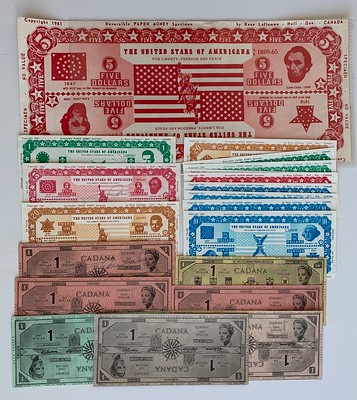 Top, bottom, face and back are all identical, to save time in arranging notes in a wallet. Design concept by Rene Laflamme, Hull, 1961: notes adorned with Grace Kelly portrait and provincial shields, not engraved. Eight $1 examples in various colours, UNC, one has been autographed, in the original envelope from the Canadian Numismatic Association Convention of 1961 at Hamilton, "with the compliments of Rene Laflamme B. L. Ph."
Top, bottom, face and back are all identical, to save time in arranging notes in a wallet. Design concept by Rene Laflamme, Hull, 1961: notes adorned with Grace Kelly portrait and provincial shields, not engraved. Eight $1 examples in various colours, UNC, one has been autographed, in the original envelope from the Canadian Numismatic Association Convention of 1961 at Hamilton, "with the compliments of Rene Laflamme B. L. Ph."
Also United States equivalents, also by Rene Laflamme, in denominations of $1 (2), $5 (2), $10 (3), $20 (1), and additional set of $1, $5, $10 and $20 which have been autographed. All UNC. Lot also includes a similar $5 but in huge format, AU.
Interesting concept. The group would make for a nice display. -Editor
To read the complete lot description, see:
H. Don Allen Collection - Reversible Money Concept Notes
(http://auctions.gbellauctions.com/H-Don-Allen-Collection-Reversible-Money-Concept-Notes_i38481573)
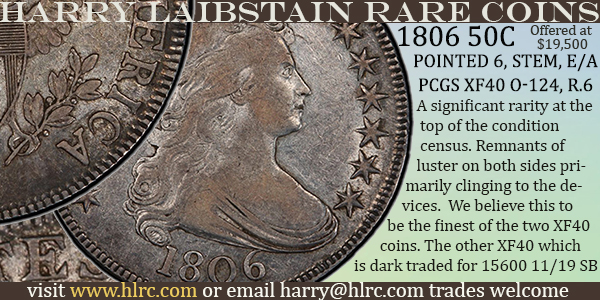
NUMISMATIC NUGGETS: SEPTEMBER 27, 2020
Here's a selection of interesting or unusual items I came across in the marketplace this week. Tell us what you think of some of these. -Editor
1855 Experimental Alloy Cent
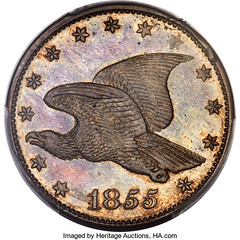
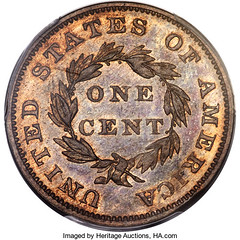
1855 Experimental Alloy Cent
Judd-170a, PR64+
1855 1C Flying Eagle Cent, Judd-170a, R.7, PR64+ PCGS. Ex: Simpson. Thirteen stars surround an eagle that is flying slightly upward, similar to the Christian Gobrecht/Titian Peale flying eagle design for the Gobrecht dollars (and soon the Flying Eagle cents). The reverse design is similar to the issued large cent. The diameter is intermediate between the large cents struck for commerce in 1855 and the small cents that were first produced in 1856. Struck with a plain edge. In a former auction appearance, this piece had a composition stated on the insert of 86% copper, 14% nickel. Orange borders frame olive-gray centers. Well preserved and typically struck with a minor retained obverse lamination at 1 o'clock. Struck from boldly clashed dies.
Recently sold by Heritage from the Bob R. Simpson collection. -Editor
To read the complete lot description, see:
1855 1C Flying Eagle Cent, Judd-170a, R.7, PR64+ PCGS....
(https://coins.ha.com/itm/patterns/1855-1c-flying-eagle-cent-judd-170a-r7-pr64-pcgs/a/1310-10180.s)
1875 Australia Bravery Award
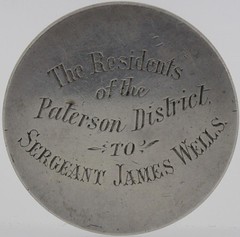
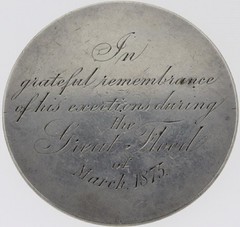
After forty days of rain vulnerable buildings were destroyed along with livestock and the districts crops of maize and tobacco. The paper reported that large quantities of property of every description have been noticed to have been swept down by the fearful torrent of water including a continuous stream of pumpkins. Able-bodied locals toiled day and night to rescue people stranded by the rising waters and the Advertiser reported that throughout Sunday Night and all day on Monday, Senior Constable James Wells, and Constable William Mayo, of our police force, who, with Messrs Thomas Lindsay, Boyle, White and Frederick Wilson formed the boats crew, were mostly actively engaged in rendering assistance in removing flooded-out residents from dwellings to places of safety.
Wells himself lost his footing on one occasion and was nearly swept away to his death before he was able to desperately grasp a branch and be pulled to safety. Amazingly, the only reported casualty of the Flood was the local member of the Legislative Council, William Munnings Arnold who tragically drowned while trying to save a boatload of pumpkins, which were probably fished from the fast-flowing waters. It seems that sometimes you just have to let them go. In December 1875 Sergeant Wells and five other principal members of the boats crew were presented with bravery medals for their heroics during the Flood. The hand-engraved silver discs were crafted by the famous silversmiths Hardy Brothers of Hunter Street, Sydney.
It's not pretty, but it's pretty important. And if you come across a boatload of floating pumpkins, let them float by. -Editor
To read the complete lot description, see:
Lot 6: Australia. 1875 Bravery Award from "The Residents of the Patterson District to Sergeant James Wells," Extremely Fine
(https://www.invaluable.com/auction-lot/australia-1875-bravery-award-from-the-residents-o-6-c-21e4305b90)
French Gas and Electricity Medal
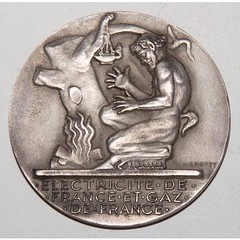
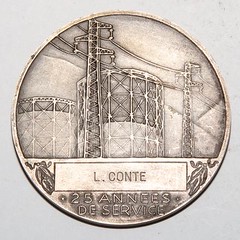
Silver plated Bronze medal, French gas and Electricity medal awarded for 25 years of service to L. Conte Henri Dropsy (1885-1969) In original circular case.
I enjoy the history of science, technology and business. Industry service medals are an interesting specialty that are challenging to collect. I like this one. Unusual. -Editor
To read the complete lot description, see:
25 YEARS OF SERVICE MEDAL BY HENRI DROPSY
(https://bid.alexcooper.com/lots/view/1-3K8GS7/25-years-of-service-medal-by-henri-dropsy)
Squatting Numismatica Medal
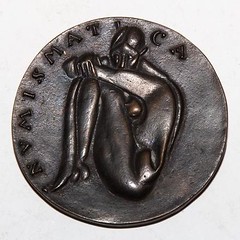
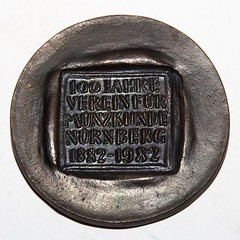
1982 Bronze Medal von Uhlig 100 year anniversary of The Association of Coin Studies - Squatting Numismatica 159.8 Grams.
I'd never seen this medal and I'm unfamiliar with the organization that issued it - can any of our readers fill us in? Verein für Münzkunde Nürnberg eV is still active - here's their website:
http://www.vfm-nbg.de/
-Editor
To read the complete lot description, see:
100TH ANNIVERSARY MEDAL FOR COIN STUDIES MEDAL
(https://bid.alexcooper.com/lots/view/1-3K8GS9/100th-anniversary-medal-for-coin-studies-medal)
THE BOOK BAZARRE
MONEY PEOPLE HATED: DAMNATIO MEMORIAE
Mike Markowitz penned an article this week for his CoinWeek Ancient Coin Series about damnatio memoriae on ancient Roman coins. Here's an excerpt - be sure to read the complete article online. -Editor
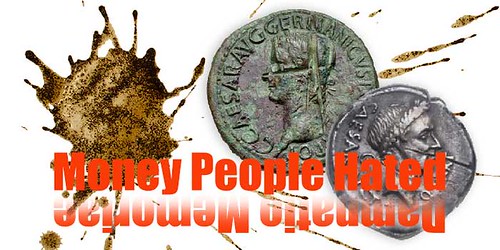
ANCIENT COINS OFTEN took a beating in circulation, remaining in use for decades or even centuries. But some surviving coins seem to have been deliberately defaced or mutilated as an expression of popular hatred and contempt for the subject depicted or name inscribed. A 17th-century scholar coined the Latin phrase damnatio memoriae ("damnation of memory") for this practice, though there is no evidence for the use of the phrase in antiquity.
Coins mistreated in this way have a certain perverse appeal to some collectors, and a few dramatic examples have brought impressive prices at auction. Coins become damaged for many different reasons – sometimes the shovel or trowel that unearths a coin leaves a gouge in the metal – and unscrupulous sellers may try to misrepresent modern damage as ancient, so damnatio memoriae is hard to prove. Cataloguers often follow the phrase with a cautious question mark.
Gaius Julius Caesar was beloved by his troops and Rome's common people, but he was hated by many of the elite; indeed a faction of the Senatorial class hated him enough to stab him to death.
When Caesar's portrait was placed on a silver denarius in January 44 BCE, it violated a long-standing Roman taboo against depicting living persons on the coinage. A deep scratch across the face on this rare coin could be an expression of damnatio — or at least the auction cataloguer thought so. Lifetime portrait coins of Julius Caesar are in such high demand from collectors that even a deep scratch is an acceptable defect.
To read the complete article, see:
Money People Hated: Damnatio Memoriae on Ancient Roman Coins
(https://coinweek.com/ancient-coins/money-people-hated-damnatio-memoriae-on-ancient-roman-coins/)
To read earlier E-Sylum articles, see:
FEATURED WEB PAGE: DAMNATIO MEMORIAE
(https://www.coinbooks.org/esylum_v16n14a27.html)
QUERY: DAMNATIO MEMORIAE OF ROMAN EMPERORS SOUGHT
(https://www.coinbooks.org/esylum_v19n08a18.html)

COIN REPRESENTED THE FIVE WOUNDS OF CHRIST
A medieval coin used for jewelry was recently declared treasure. The five points of damage likely once held gems representing the five wounds of Christ. Interesting religious artifact. I've added a related image from a 1495 book at Oxford's Bodleian Library depicting the Five Sacred Wounds of Christ. -Editor
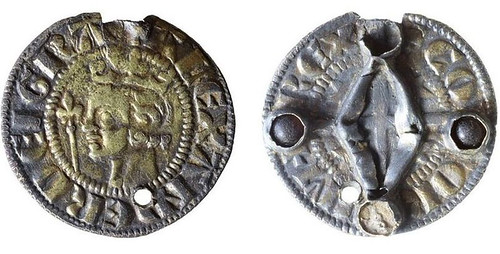
A centuries-old coin has been declared treasure after being found by a metal detectorist in a field in Norfolk.
The silver coin would have been adorned with gems which have fallen out over the centuries, and is believed to be 740 years old.
An image of historic King Alexander III of Scotland can be found on one side of the coin which is dated as being from 1280-6, and experts believe the artefact would have been worn as either a pendant or a brooch by someone that worked within religion.
It was discovered in Long Stratton, Norfolk in August 2019 but has only now been defined as treasure.
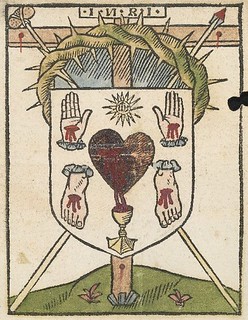 Dr Marsden told the BBC : "There is also settings for gems [which were no longer present] which represent the five wounds of Christ, so it is symbolic and adds to the religious dimension."
Dr Marsden told the BBC : "There is also settings for gems [which were no longer present] which represent the five wounds of Christ, so it is symbolic and adds to the religious dimension."
He explained that the original owner "would have been relatively well-off" as the penny was the equivalent of half a day's wage of 1280 standards.
He explained: "It would have been a bit of a luxury and the owner would have some social status."
To read about the Five Holy Wounds, see:
Five Holy Wounds
(https://en.wikipedia.org/wiki/Five_Holy_Wounds)
The Five Wounds of Christ
(https://thejesusquestion.org/2015/03/03/in-song-and-picture-the-color-of-christs-passion/five-wounds-of-christ-2/)
To read the complete article, see:
Medieval coin with 'five wounds of Jesus Christ' found and declared treasure
(https://www.dailystar.co.uk/news/latest-news/medieval-coin-five-wounds-jesus-22714303)
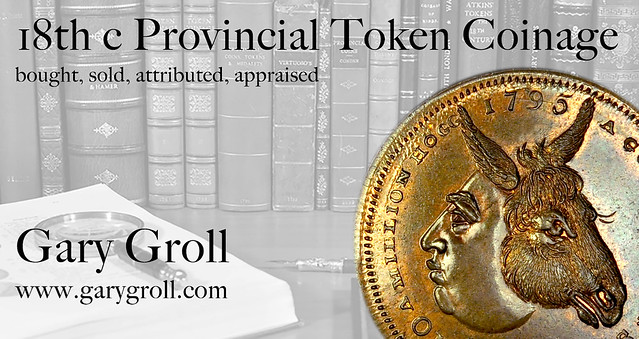
THE SINAW HOARD FOUND IN OMAN
This recent article discusses the largest coin hoard discovered in Oman, Jordan. The hoard was found in 1979 and is now on display in the National Museum. Found via The Explorator newsletter. To subscribe to Explorator, send a blank email message to: explorator+subscribe@groups.io. -Editor
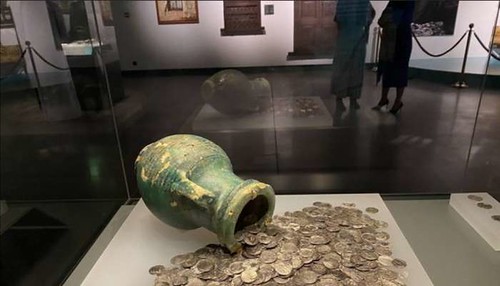
A statement issued by the Oman News Agency (ONA) said, "The Sinaw archaeological treasure is the largest coin treasure found in the Sultanate until today. It was found inside a pottery vessel in Shawwal 1399/September 1979 in the Sinaw district in the state of Al Mudhaibi in the North Al Sharqiyah Governorate. The glazed vessel is distinguished in turquoise blue and has handles on both sides. Inside the vessel, 962 pieces of silver dirhams, dating back to the early Sasanian and Islamic eras were found."
To read the complete article, see:
Sinaw treasure is largest currency treasure unearthed in Oman
(https://timesofoman.com/article/sinaw-treasure-is-largest-currency-treasure-unearthed-in-oman)
RENAISSANCE PLAQUETTE ATTRIBUTED TO LOMBARDO
In their November sale, Morton & Eden are offering a rare and important Renaissance plaquette. -Editor
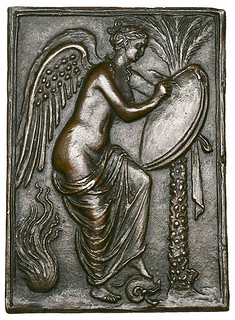 An important early 16th century Renaissance plaquette, depicting Victory inscribing a Shield, has recently been re-attributed to the renowned Italian Renaissance sculptor Antonio Lombardo (c.1458–1516), and is one of the highlights of Morton & Eden's forthcoming sale of Coins, Medals and Banknotes on 4 November 2020.
An important early 16th century Renaissance plaquette, depicting Victory inscribing a Shield, has recently been re-attributed to the renowned Italian Renaissance sculptor Antonio Lombardo (c.1458–1516), and is one of the highlights of Morton & Eden's forthcoming sale of Coins, Medals and Banknotes on 4 November 2020.
Tom Eden, of Morton & Eden, said: "This, hitherto, virtually unknown plaquette is believed to be the only known casting of this subject. Its recent attribution to the Renaissance artist Antonio Lombardo, the court sculptor of Alfonso I d'Este, Duke of Ferrara makes it an exceptionally exciting new art historical discovery."
The bronze rectangular plaquette is small, measuring only 50.8 by 36.2mm, and depicts, in exceptionally fine relief, a standing winged figure of Victory. Victory is shown, one foot resting on a helmet, inscribing a shield set upon a palm tree, with a flaming artillery projectile behind her. It is estimated to fetch £40,000-60,000.
Although the plaquette was known to be in two highly distinguished French collections during the 19th and early 20th centuries, at that time scholars could not shed much light on who it was executed by or why.
Morton & Eden recently consulted Dr Jeremy Warren, Honorary Curator of Sculpture, Ashmolean Museum, Oxford, and Sculpture Research Curator, The National Trust, a leading specialist in this field. It is thanks to Dr Warren's subsequent additional research that this significant new attribution can now be proposed.
The source for the image of the plaquette, Victory inscribing a shield, is clearly based on a form found on Roman coins. The same image was also used by another Renaissance sculptor, as can be seen in a similar plaquette attributed to the artist Andrea Riccio (c. 1470 – 1532).
Although the main figure of Victory is the shared motif, in every other respect this plaquette is quite distinct. Here Victory is depicted nude with the exception of drapery over her lower limbs, and, in comparison to the version by Riccio, this plaquette has an elegant neo-classical feel to its execution.
It is, however, the flaming artillery projectile shown behind Victory that provides the most conclusive evidence to support the re-attribution. In all likelihood the subject of the plaquette was a direct allegory of the victory of Alfonso I d'Este and the French at the Battle of Ravenna on 11 April 1512. It was at the Battle that Duke Alfonso made use for the first time of a deadly new weapon he had developed, a metal ball filled with an artificial fire, which would explode into flying fragments when it hit its target.
To read the complete article, see:
New research leads to exciting re-attribution of important Renaissance plaquette
(https://artdaily.cc/news/128642/New-research-leads-to-exciting-re-attribution-of-important-Renaissance-plaquette#.X3CSsmhKhPY)
To visit the Morton & Eden website, see:
https://www.mortonandeden.com/
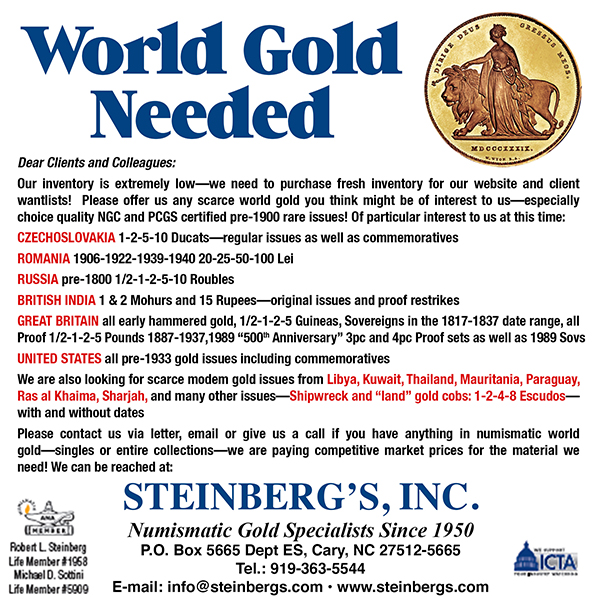
THE 1864 ATLANTIC INTERNATIONAL CLUB MEDAL
Peter van Alfen penned an interesting short article on the American Numismatic Society Pocket Change blog about a curious 1864 medal. Here's an excerpt - see the complete article online. -Editor
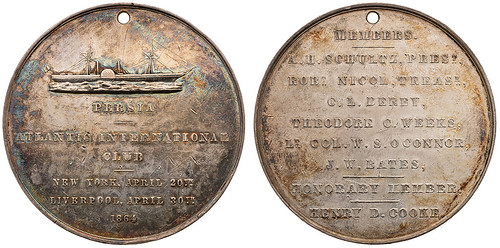
Among the more unusual and curious objects in the ANS's collection is a silver medal (ANS 1967.225.23) 56.8 mm in diameter that was donated to the Society, along with ca. 3,000 other medals, in 1967 by the Wadsworth Athenaeum, which had received the medals as a bequest from J. Coolidge Hills in the 1920s.
The obverse of the medal depicts the paddlewheel steamship RMS Persia and is inscribed "The Atlantic International Club" along with the dates of a voyage from New York City to Liverpool between April 20th and 30th, 1864.
The reverse of the medal lists the "Members" of the Club including A.H. Schultz, Pres., Robt. Nicol, Treas., C.L. Derby, Theodore C. Weeks, Lt. Col. W.S. O'Connor, J.W. Bates, and the "Honorary Member," Henry D. Cooke. There is no record of such a Club existing in either the US or England so it is probable that this medal commemorates an ephemeral association of a half dozen or so gentlemen who perhaps met for the first time and formed friendships during their ten-day Atlantic crossing in April 1864.
To read the complete article, see:
THE ATLANTIC INTERNATIONAL CLUB, 1864
(http://numismatics.org/pocketchange/aic/)
DICKIN MEDAL FOR CAMBODIAN LANDMINE RAT
The latest Dickin Medal award goes to... a rat! -Editor

A rat is being honored with one of the highest awards in the animal world after he has potentially saved numerous lives for clearing landmines from fields in Cambodia.
Magawa, an African Giant Pouched Rat, was awarded a gold medal from the PDSA, a British veterinary charity, for his work over the past seven years leading to the detection of 39 landmines and 28 unexploded items and clearing more than 20 soccer fields in the process.
"This is the very first time in our 77-year history of honoring animals that we will have presented a medal to a rat," said John Smith, the chairman of PDSA.
The PDSA has awarded its gold medal to 29 other animals, all dogs, for "animal bravery and exceptional devotion to duty." The medal for Magawa was specially designed to fit onto his work harness, said Jan McLoughlin, PDSA's director general.
APOPO rats like Magawa undergo training from a young age, and it's safe for them to work in landmine detection because they are light enough not to trigger the explosives, said Christophe Cox, CEO and co-founder of the charity.
"The rats cannot miss any landmine," Cox added. "We really trust our rats, because very often after clearing a minefield, our teams will play a game of soccer on the cleared field to assure the quality of our work."
In Cambodia, around three million landmines remain hidden, and tens of thousands of people in the country have died or been injured, often causing amputations, from the unexploded mines.
"Magawa is a true hero rat," McLoughlin said.
So now we have a new variety of the medal to record in the numismatic catalog - the rat-sized version! -Editor
To read the complete articles, see:
Medal for the boomtown rat who detects landmines
(https://www.thetimes.co.uk/article/dickin-medal-for-the-boomtown-rat-87q5cppw7)
Meet Magawa, the 'hero rat' awarded a bravery medal for detecting dozens of landmines
(https://www.usatoday.com/story/news/world/2020/09/25/rat-magawa-gets-pdsa-gold-medal-detecting-landmines-cambodia/3528457001/)

LOOSE CHANGE: SEPTEMBER 27, 2020
Here are some additional items in the media this week that may be of interest. -Editor
Why Cambodia Became a French Protectorate
The Künker Newsletter of September 25, 2020 includes an article on how Cambodia became a French protectorate. -Editor
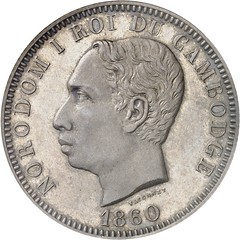
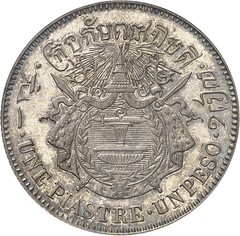
Much injustice was done when the European powers divided the world among themselves. Superior weapons weren't the only reason why they could do that. Local conflicts made it easier for exterior powers to interfere, as it was the case regarding the fall of King Norodom I of Cambodia.
A coin featuring the date of 1860 bears witness to the first contacts between France and the Cambodian ruler.
To read the complete article, see:
Why Cambodia Became a French Protectorate.
(https://www.kuenker.de/en/information/presseinformationen/aktuelle-mitteilungen/324)
Peak Gold?
Dick Hanscom forwarded this BBC News article about all the gold in the world. -Editor
Experts talk about the concept of peak gold - when we have mined the most we ever can in any one year. Some believe we may have already reached that point.
Gold mine production totalled 3,531 tonnes in 2019, 1% lower than in 2018, according to the World Gold Council. This is the first annual decline in production since 2008.
"While the growth in mine supply may slow or decline slightly in the coming years, as existing reserves are exhausted, and new major discoveries become increasingly rare, suggesting that production has peaked may still be a little premature," says Hannah Brandstaetter, a spokesman for the World Gold Council.
To read the complete article, see:
How much gold is there left to mine in the world?
(https://www.bbc.com/news/business-54230737)
Conservation: Fragmentary Early Menagerie Poster
Bibliophiles will appreciate this tale of the painstaking restoration of a large circus poster at the American Antiquarian Society. -Editor
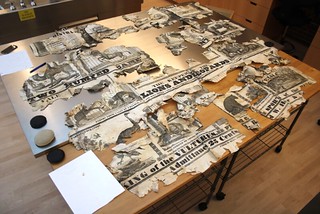 Not long after my arrival in Worcester, followed by a 14-day quarantine in the charming Montvale Cottage, I saw the poster in the flesh. It sat in a pile of folded and tattered fragments. A note perched on top of the heap read, "Preservation Needed." Babette explained to me that the poster awaited the completion of the new conservation lab; its dimensions were thought to exceed those of the old lab's equipment.
Not long after my arrival in Worcester, followed by a 14-day quarantine in the charming Montvale Cottage, I saw the poster in the flesh. It sat in a pile of folded and tattered fragments. A note perched on top of the heap read, "Preservation Needed." Babette explained to me that the poster awaited the completion of the new conservation lab; its dimensions were thought to exceed those of the old lab's equipment.
As we removed the fragments from the box, tigers, lion tamers, and large birds emerged. Typefaces of all kinds declared fantastic attractions: "King of the Vultures," an orchestra containing fourteen musicians, and large cats "as docile as any of the domestic animals."
To read the complete article, see:
Conservation of a Fragmentary Early Menagerie Poster
(https://pastispresent.org/2020/good-sources/conservation-of-a-fragmentary-early-menagerie-poster/)
FEATURED WEB SITE: ENGLISH HAMMERED COINS
This week's Featured Web Site features English Hammered coins in the collection of Timothy D. Cook.Welcome to my virtual coin cabinet. With the advent of computers and technology, I am now able to view and enjoy my collection in a new and different way. I am also now able to share my collection with others, which was something I was not able to do before. I live in a remote area of Montana which has few people, and even fewer coin collectors, especially those who would appreciate my collection. In addition the collection is kept in a bank vault some distance from my home. This has become frustrating in that I have not been able to view my collection as much as I would like. Therefore, I have set up this site as a way for myself, and for other people who like English hammered coins, to see my collection.
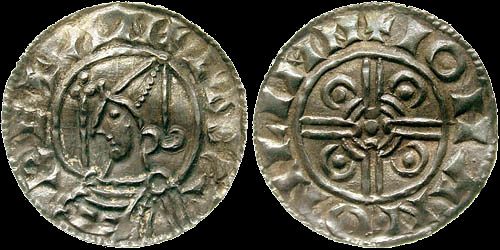
https://www.englishhammered.com/

